NFDI4Objects Community Meeting 2024
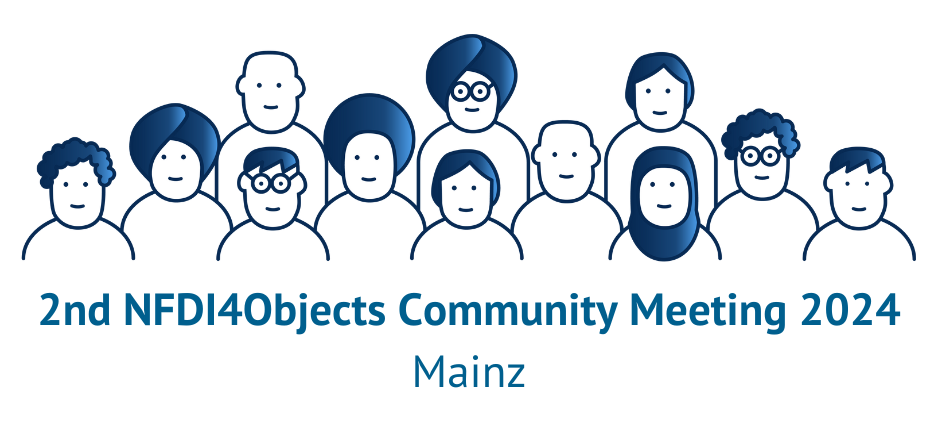
Our 2nd NFDI4Objects Community Meeting will take place in Mainz from 25 to 27 September 2024.
Review of the NFDI4Objects Community Meeting 2024
This was the 2nd Community Meeting in Mainz

The NFDI4Objects Community Meeting 2024 took place in Mainz from 25 to 27 September. With 185 participants and the support of the Leibniz Centre for Archaeology and Mainz University of Applied Sciences, the event was a complete success. The three-day conference provided a platform for intensive dialogue on strategies in research data management (RDM) and the FAIRification of object-related data.
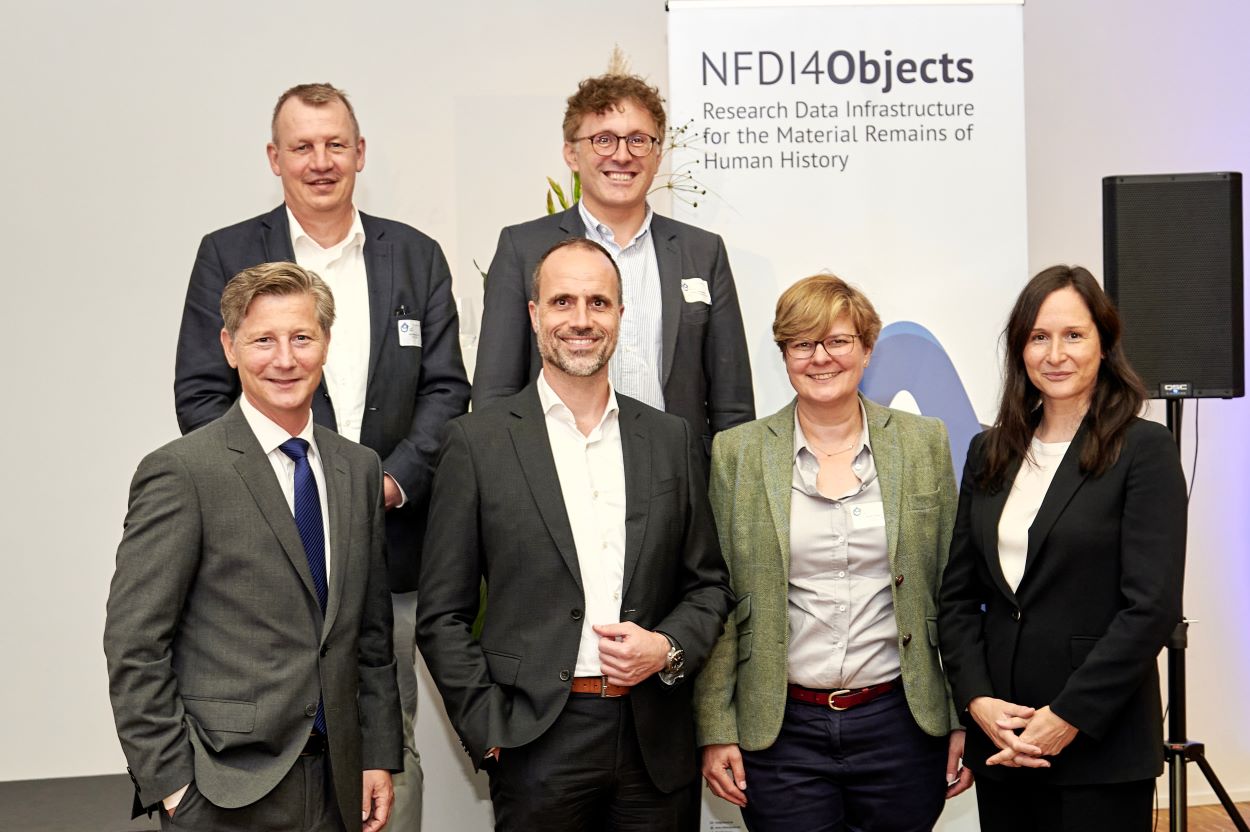
Kai-Christian Bruhn (Deputy Spokesperson NFDI4Objects), Philipp von Rummel (Speaker NFDI4Objects), Torsten Fischer (Administrative Director LEIZA), Clemens Hoch (Minister for Science and Health, RLP), Barbara Ebert (GFBio e.V.), Alexandra Busch (Chief Executive LEIZA) during the evening event © LEIZA / Sabine Steidl
Day 1: Wednesday, 25 September
The Community Meeting began on Wednesday, 25 September, with an extensive supporting programme of workshops and networking opportunities.
Workshop I
RDM training for students and doctoral candidates (Kai-Christian Bruhn)
A total of 14 participants attended Kai-Christian Bruhns’ (spokesperson for Task Area 6) training workshop at Mainz University of Applied Sciences. The participants were students from Bachelor’s and Master’s degree programmes, as well as doctoral students and postdocs from various universities. They were taught the basics of research data management (RDM) in small, sometimes very data-intensive projects such as final theses and qualification papers.
The focus was on relating general knowledge of RDM to problems in everyday practice. After the participants had formulated their own RDM stories with reference to concepts of the research data life cycle and its phases, procedures for data organisation, metadata and backup strategies were discussed. The second part of the workshop focussed on the data types most frequently used in research: texts, tables, images and geodata.
Lively discussions and many questions during the event confirmed its success. The organisers also received very good feedback on the workshop during the rest of the community meeting.
Workshop II
From the real object to the data record - indexing archaeological objects for permanent recording in database systems (Frank Dührkohp, Peter Baumeister)
The spokespersons of Task Area 5, Frank Dührkohp and Peter Baumeister, together with staff members Juliane Watson, Michael Herrmann, Doris Hartmann and Fabian Riebschläger, hosted a hands-on workshop on the indexing of archaeological objects for permanent recording in database systems.
The workshop chairs welcomed the 25 or so participants with a brief introduction to the work and developments of TA 5. In the spirit of ‘hands-on learning’, the participants were then able to familiarise themselves with and try out the TA 5’s established services Field, kuniweb, DANTE and IANUS in a relaxed atmosphere. The workshop was organised as station work in small groups. At each station, the participants first received a brief introduction to what the presented service can be used for in everyday life. They then got straight down to practical work. Under the guidance of TA 5 staff, the participants used their own laptops to record a personal data set in DANTE, link an object in the kuniweb recording database with standard data from various thesauri and ontologies, document an excavation find in Field, link it to the necessary geodata and learnt some of the basics of preparing data for long-term archiving in IANUS.
In addition to this application-orientated activity, there was of course room for individual questions and for exchanging ideas with colleagues. Even if the workshop could only serve as a first point of contact with regards to the actual handling and work with the services due to the time limit, the participants were able to gain an impression of whether and to what extent these services can support their own work.
It was great to see that neither fear of contact nor insecurity regarding personal competences in dealing with the services presented played a role. Instead, the atmosphere in the room was characterised by curiosity, cooperation and mutual support. It was a matter of course for everyone that people who unfortunately did not have Internet access on the work computers they had brought with them due to strict regulations and therefore had no access to the test environments at individual stations were able to have a look or even lend a hand themselves.
The final feedback from the participants was correspondingly positive, so that we may consider offering this type of workshop again.
Workshop III
Linked Open Data using the example of RDF data, Wikidata and Wikibase (Florian Thiery, Karsten Tolle, Tobias Arera-Rütenik)
Consortium members Florian Thiery, Karsten Tolle and Tobias Arera-Rütenik organised a hands-on workshop on the topic of Linked Open Data. The workshop was very well attended. After a few introductory words by Florian Thiery, Karsten Tolle used the example of [Nomisma.org](http://Nomisma.org) to demonstrate the benefits of using Linked Open Data. Tobias Arera-Rütenik then explained how even more complex objects, such as historical buildings, can be divided into sub-constructs and modelled. He also discussed the use of inheritance or transitivity and showed what errors can occur if used incorrectly. Florian Thiery then returned to the basics of LOD and RDF, also discussing the NFDI4Objects Knowledge Graph and its SPARQL endpoint. Karsten Tolle took this up further and used the RDFier tool to demonstrate a relatively simple way of creating RDF data from CSV files. One feature of the tool is to show different ways of modelling uncertainties.
The more than 20 participants had different levels of knowledge about LOD: from professionals to people without basic knowledge, everything was represented. The workshop chairs endeavoured to meet the different requirements of the participants. There were many questions and lively discussions and the three hours flew by.
The slides for the workshop were made available on Zenodo and GitHub.
Workshop IV
Data Café (Benjamin Höke, Bernhard Weisser, Dirk Wintergrün)
Task Areas 1, 2 and 6 organised a ‘Data Café’ on the premises of LEIZA. At six thematically different tables, the 18 participants had the opportunity to discuss various ‘application areas’ of research data management from the user’s perspective.
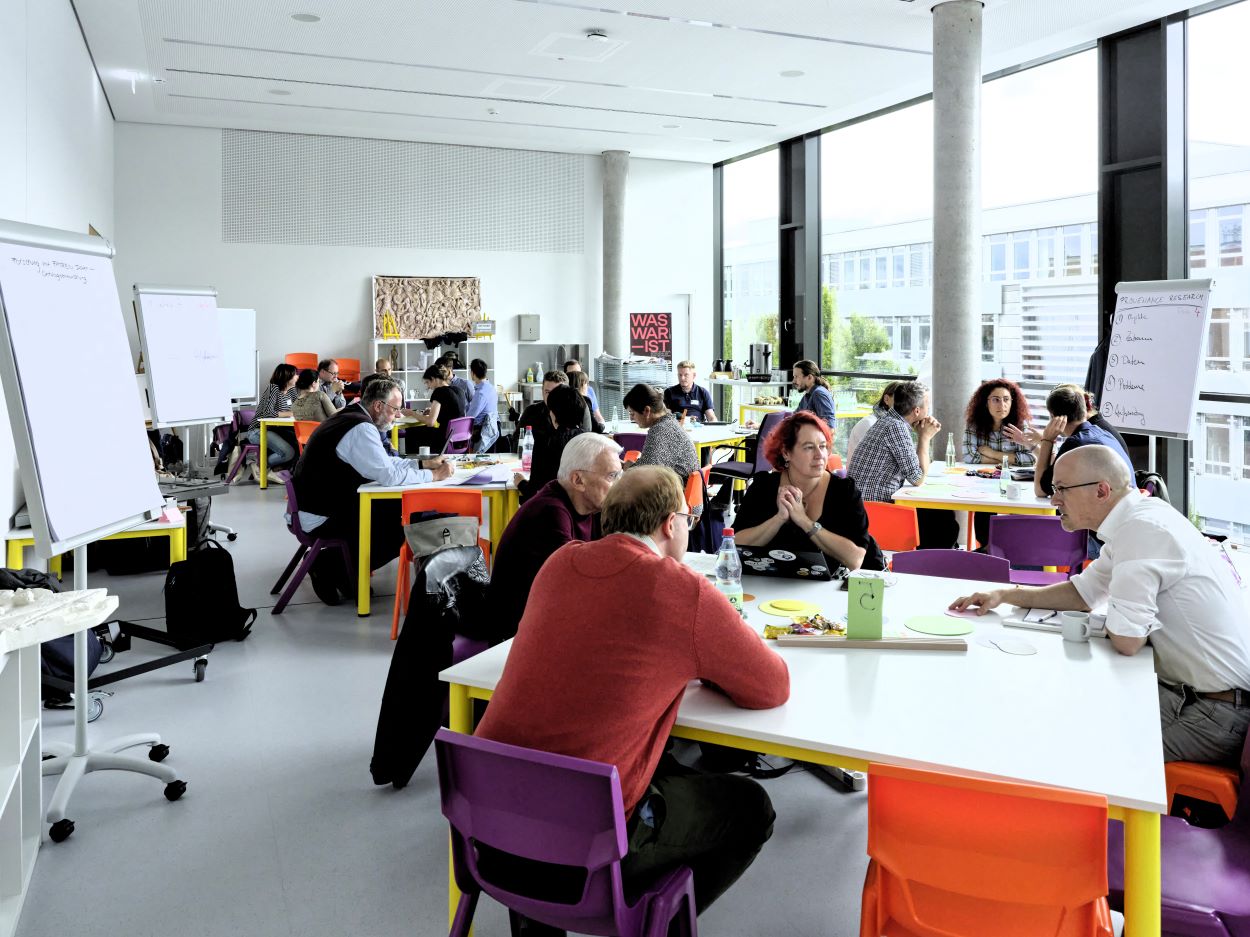
Participants of the Data Café © LEIZA / René Müller
The participants, divided into small groups, had 20 minutes per table for discussion and questions. The table chairs provided stimuli in the form of materials, introductory questions or short presentations. The topics were organised in such a way that the tables did not have to be occupied in a fixed order in order to guarantee participants an equal flow.
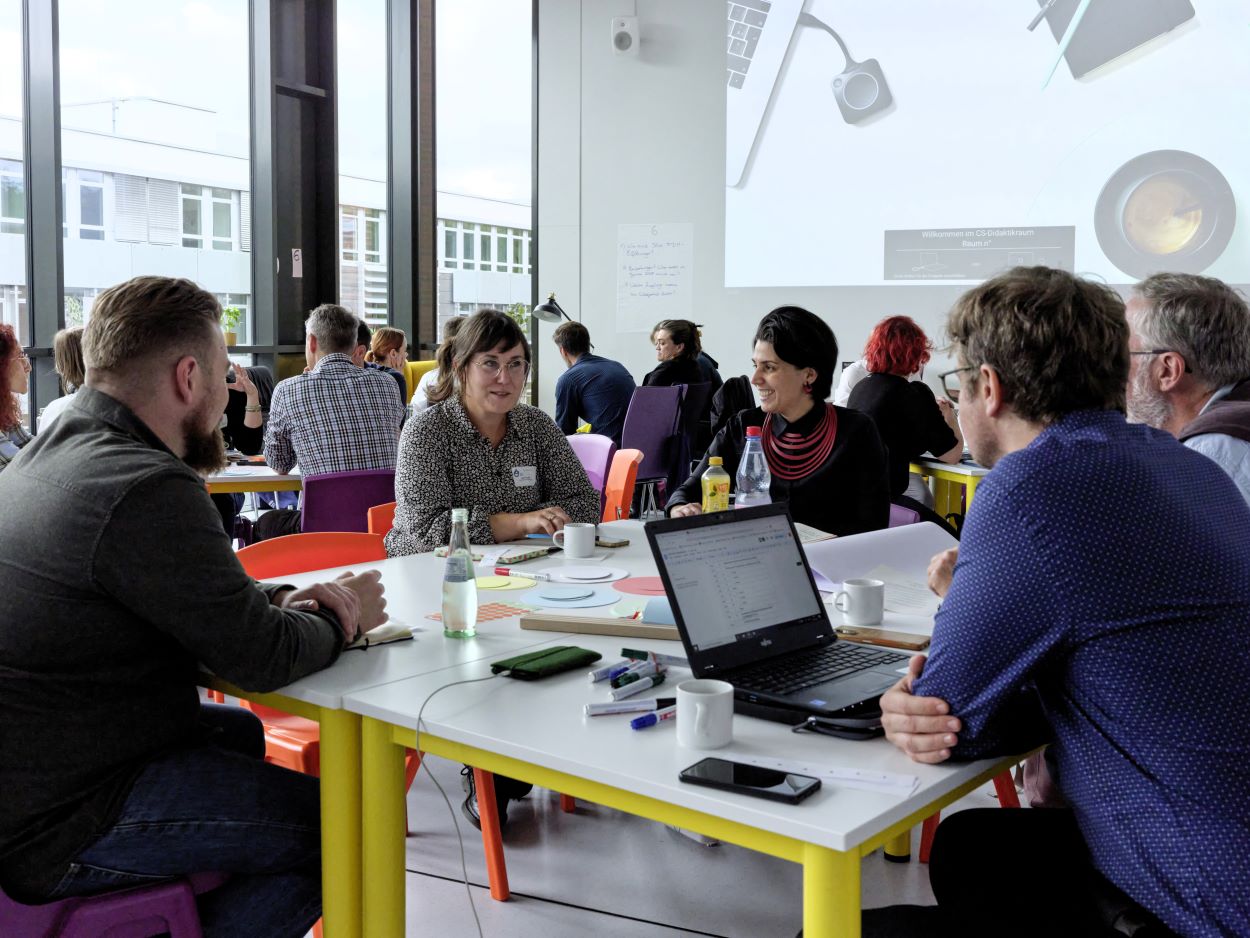
Participants of the Data Café © LEIZA / René Müller
At table 1, Jonas Abele, Benjamin Höke and Steffen Berger focussed on quality assurance measures in the course of collecting data in field research. Table 2, led by Matthias Lang and Julian Hollaender, dealt with issues relating to the 3D capture and modelling of objects and the post-processing of 3D models. Table 3 with Frank von Hagel and Christoph Klose discussed ways from collection management to digital object publication. Table 4 with Angela Berthold dealt with questions of object provenance and its modelling. At table 5, Anja Gerber and Günther Görz gave an insight into the current developments of the NFDI4Objects ontology using the example of object biographies. Table 6, with Stefanie Baars, Bernhard Weisser and Dirk Wintergrün, was dedicated to general questions about the community’s expectations of the focal points and results of NFDI4Objects.
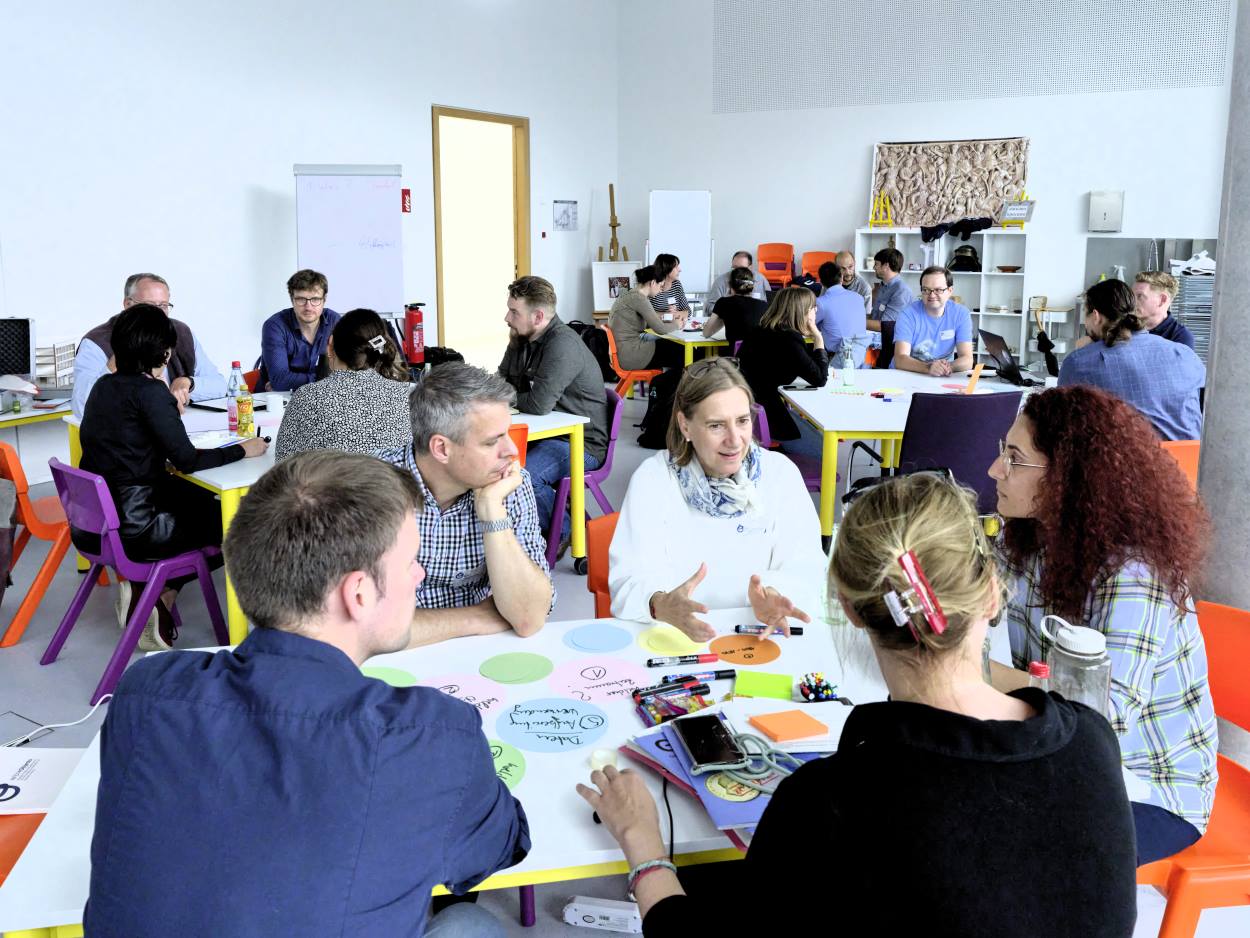
Participants of the Data Café © LEIZA / René Müller
The workshop was a complete success and, on the one hand, offered the participants a discussion forum for the first exchange with the experts present before the start of the official part of the community meeting. On the other hand, it led to lively discussions regarding the needs of the participants on RDM issues and enabled an exchange on their expectations of the consortium. The impetus provided strengthens the community connection to NFDI4Objects and allows us to work together to achieve our goals in the NFDI.
Networking in the evening
The NFDI4Objects Steering Committee and Advisory Board met in parallel to the workshops. In the evening, the President of Mainz University of Applied Sciences hosted an Ice Breaker in the LUX Pavilion, which provided a relaxed atmosphere and initial networking opportunities.
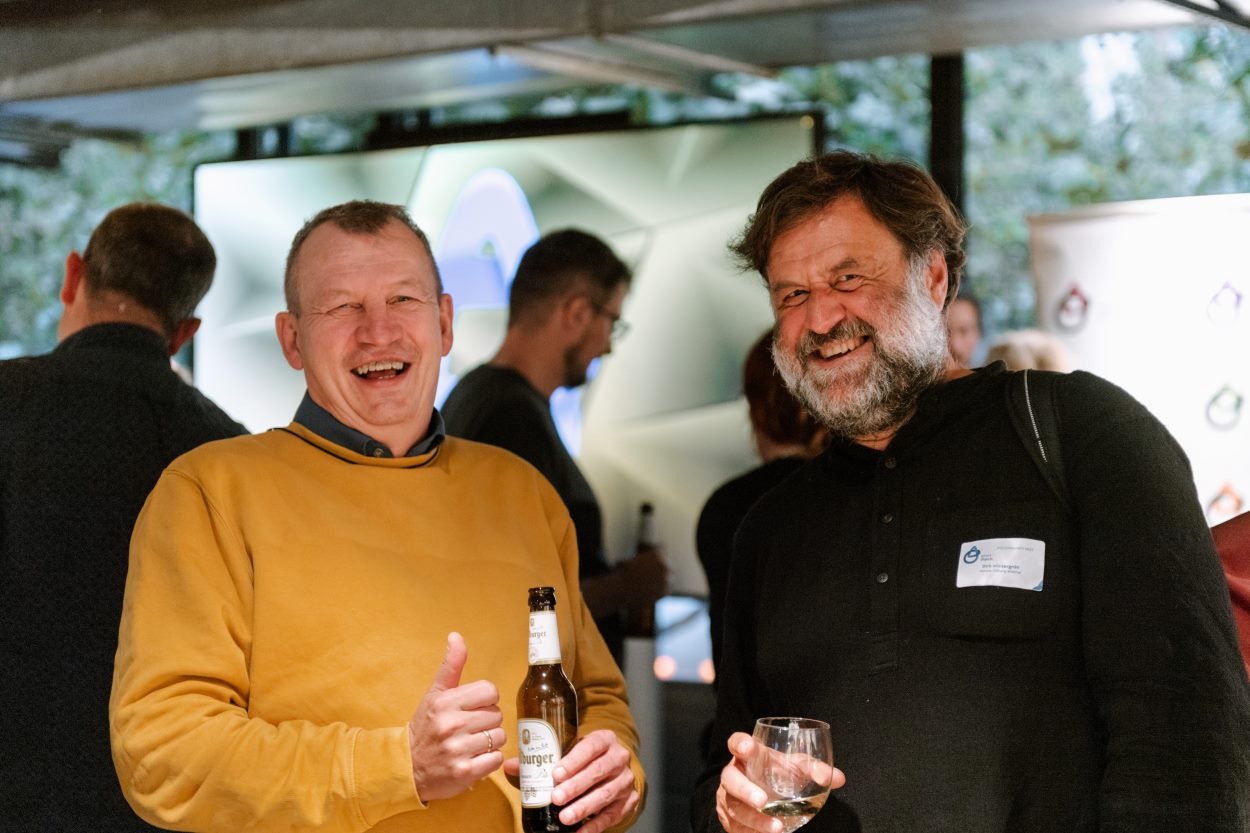
Speakers of Task Area 6 (Kai-Christian Bruhn, Dirk Wintergrün, from left to right) during the Ice Breaker. © Vanessa Liebler
Day 2: Thursday, 26 September
The core programme of the conference took place on Thursday, 26 September. The Director of the Leibniz Centre for Archaeology, Alexandra Busch, and the President of Mainz University of Applied Sciences, Susanne Weissman, opened the second day of the conference with their warm welcoming addresses.
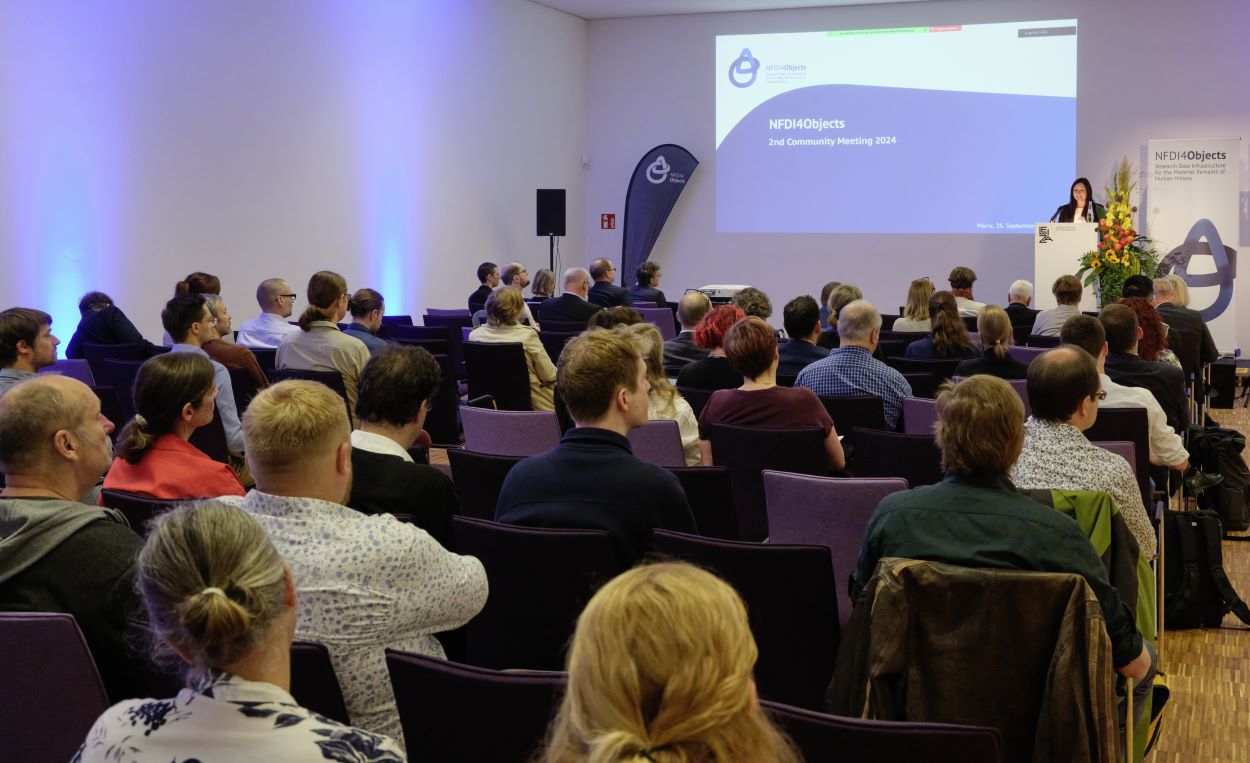
The Director of the Leibniz Centre for Archaeology, opens the second day of the conference with a welcoming address. © LEIZA / René Müller
Presentations from the task areas
The speaker of NFDI4Objects, Philipp von Rummel, began the lecture part of the main programme with an introduction to the consortium and presented the progress made in the work programme in 2024.
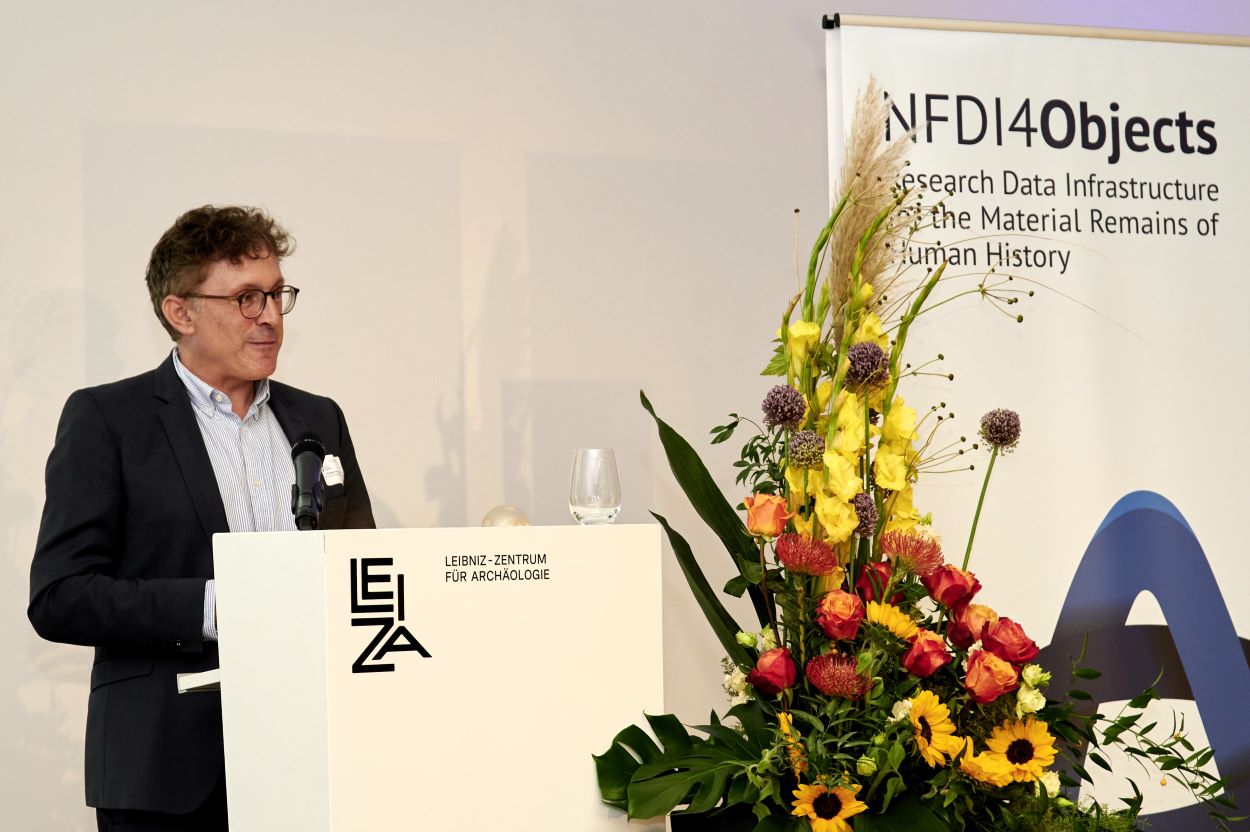
The speaker, Philipp von Rummel, briefly introduces the consortium. © LEIZA / Sabine Steidl
The speakers of the task areas, or their representatives, then presented their services. The overarching setting was an imaginary excavation site. Using the Data Life Cycle, all steps of the object biography were explained, from the discovery of an object to the curation of the data set in a database, and examples were given of how NFDI4Objects can support the members of the community in research data management and the FAIRification of their data with the services developed in the consortium. The slides of the presentations of Task Areas 1 to 6 can be found on Zenodo. After the presentations of the Task Areas, there was also room for questions and discussion with the audience.
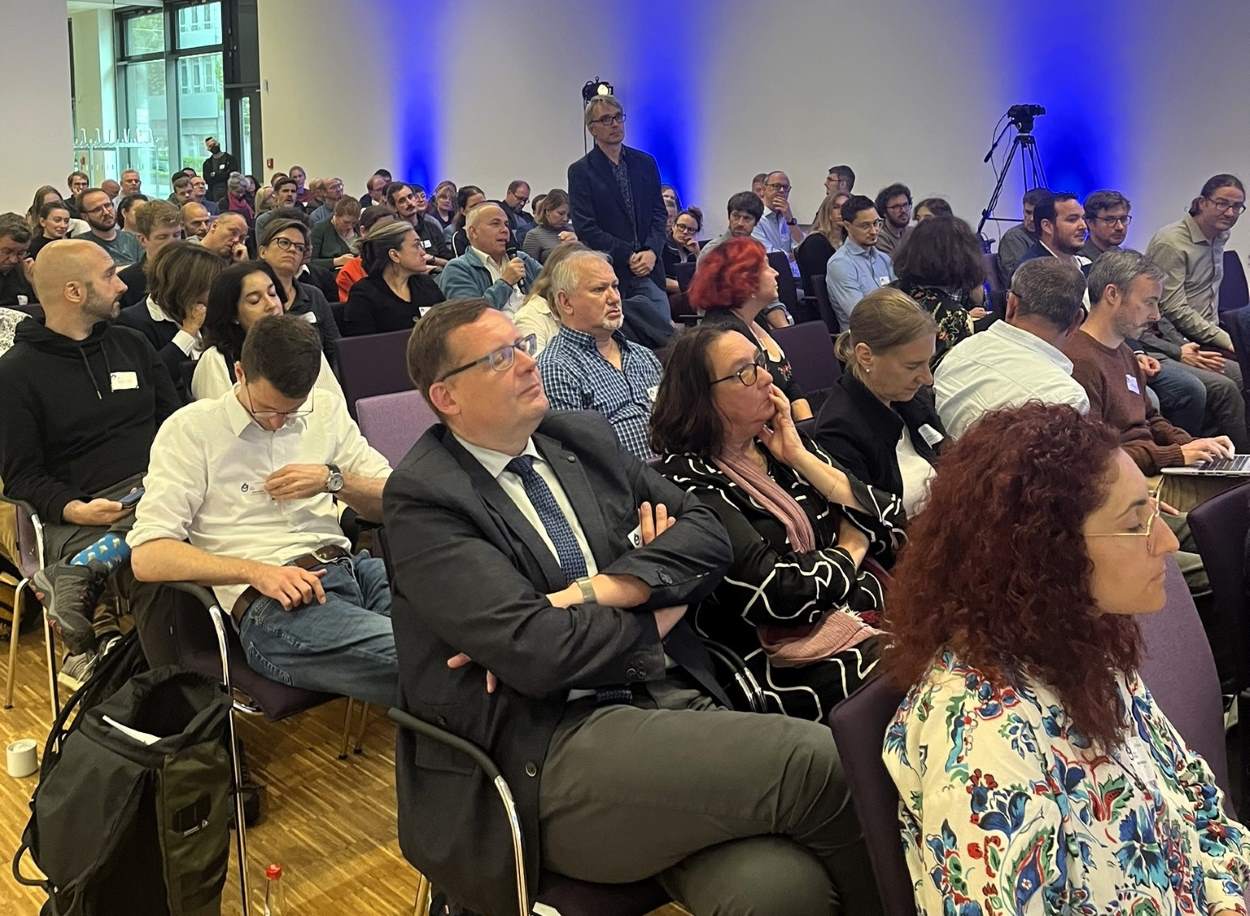
The audience eagerly followed the TA presentations. © Tamina Grasme
Marketplace
The Marketplace started after the lunch break: a place for interaction. As a contrast to the frontal presentations, the participants of the Community Meeting were able to interact with others here.
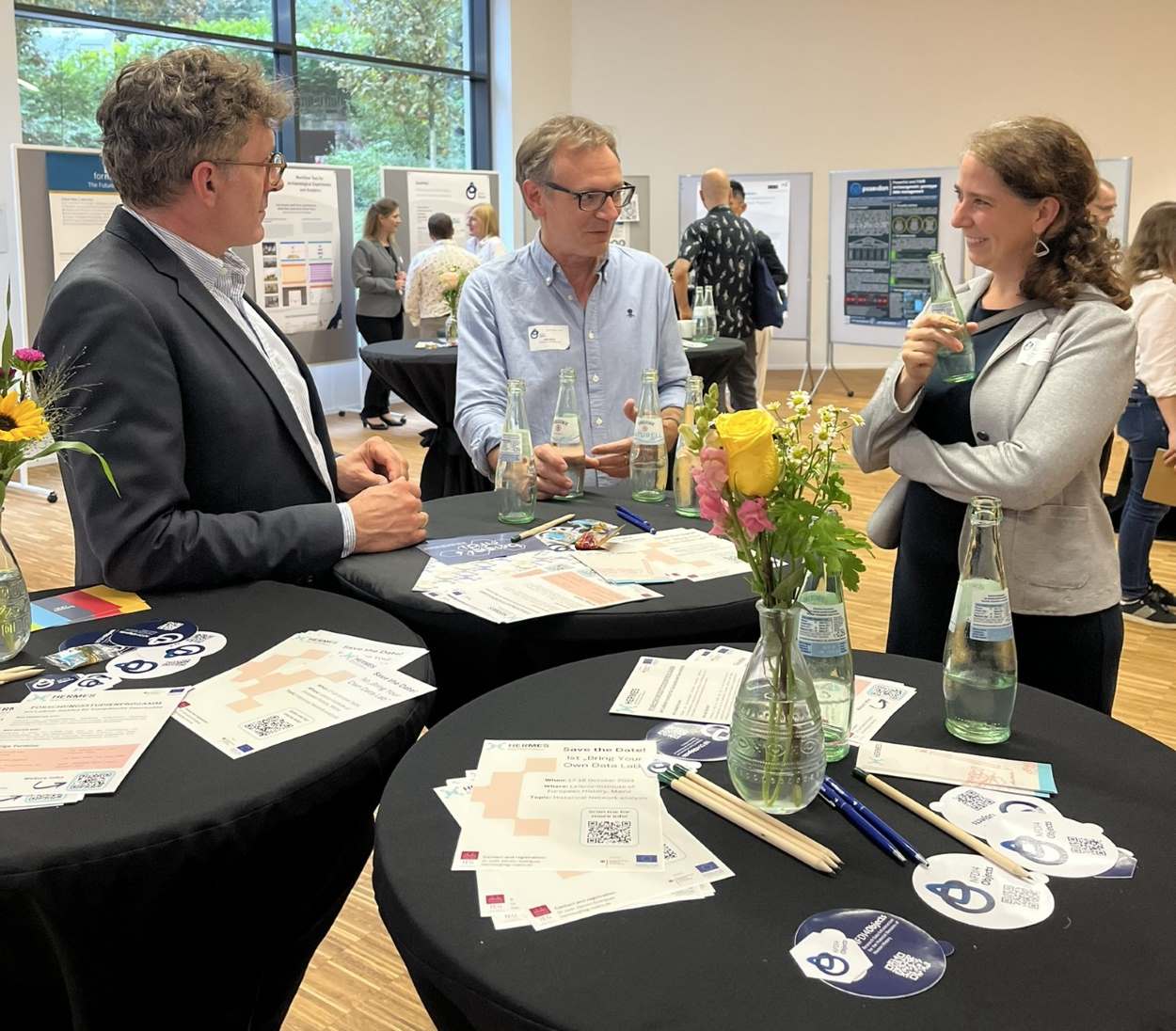
During the Marketplace, there was plenty of time to talk to others from the community. © Tamina Grasme
Poster Session
A total of 37 posters were presented during the poster session. All NFDI4Objects task areas, many of the community clusters, temporary working groups and services of the consortium were represented. The Data Competence Centres SODa, WiNoDa, HERMES and DKZ.2R were also represented and had staff on hand to answer questions on their posters. We were particularly pleased with the participation of other NFDI consortia such as NFDI4Culture, NFDI4Memory, NFDI4Earth and Base4NFDI with some basic services.
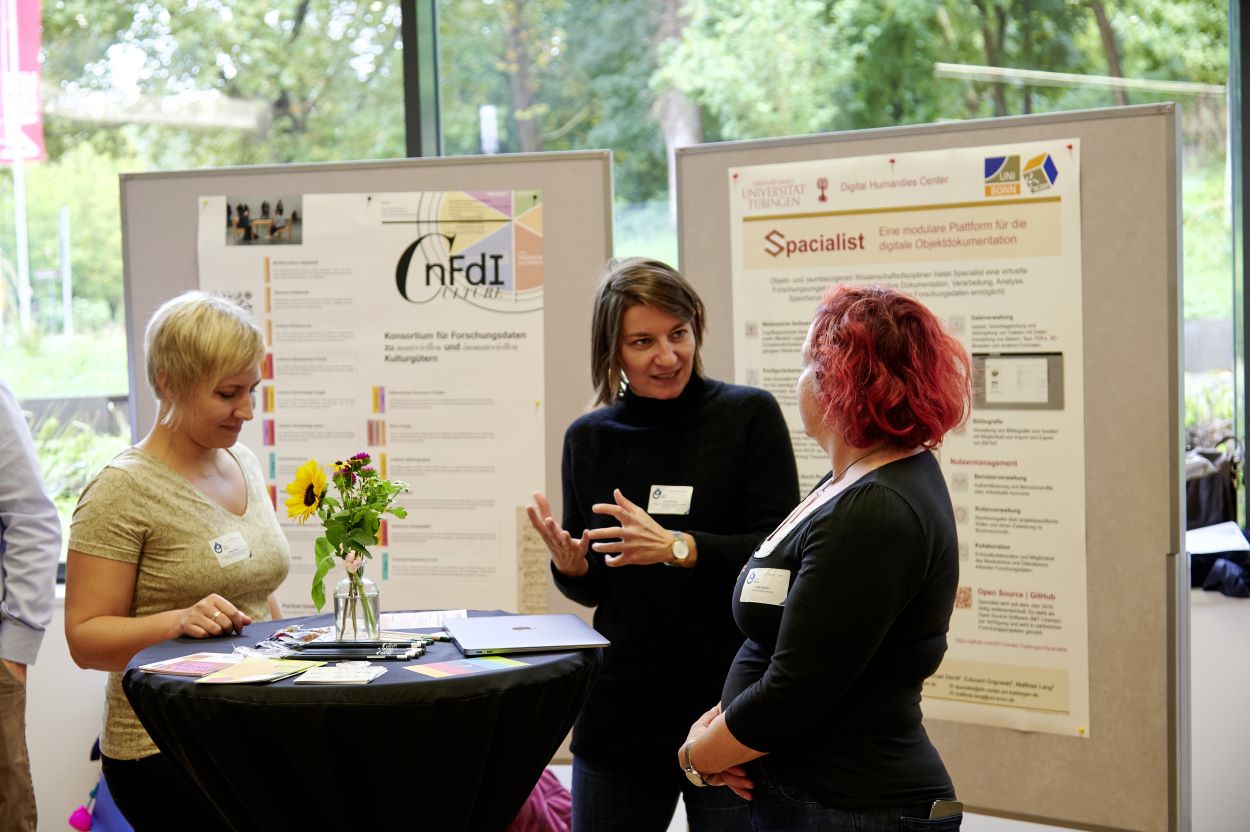
Among the posters on display were several from consortia close to us, such as this one from NFDI4Culture. © LEIZA / Sabine Steidl
Parallel to the poster session, the Dataship Sneak Peeks and then the Ignite Talks took place on the podium.
Dataship Sneak Peeks
This year, the NFDI4Objects Dataship was announced for the first time. The three-month fellowship offered financial support and professional mentoring for the four winners to process their various existing datasets according to the FAIR principles and publish them as open access. The four fellows (Anne Herzberg-Beiersdorf, Cornelia Lechner, Hristina Ivanova, Hristina Ivanova) presented their projects at the community meeting. You can read all about the Dataship and the projects supported this year on our website.
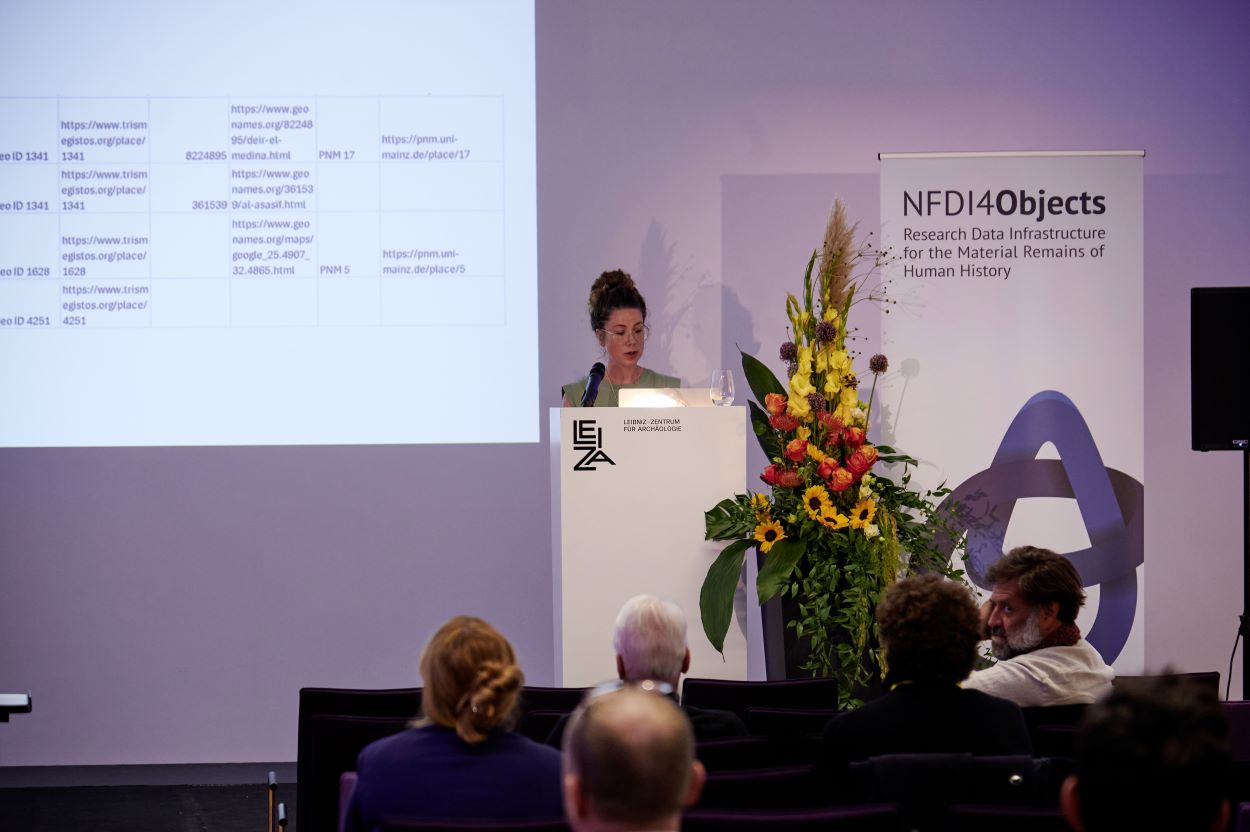
Dataship-winner Anne Herzberg-Beiersdorf presents her project. © LEIZA / Sabine Steidl
Ignite Talks
After the Dataship winners had presented their projects, the Ignite Talks took place on the podium. A total of five people each presented a data (horror) story from their personal experience in five minutes. The slides were automatically clicked on every 15 seconds. Like an initial spark, the talks stimulated intensive discussions with the audience and the Ignite Talks sparked a direct response from the community. Thanks to Romy Köhler (member of the Community Cluster Digital Provenance Research) for the following successful summary of the Ignite Talks.
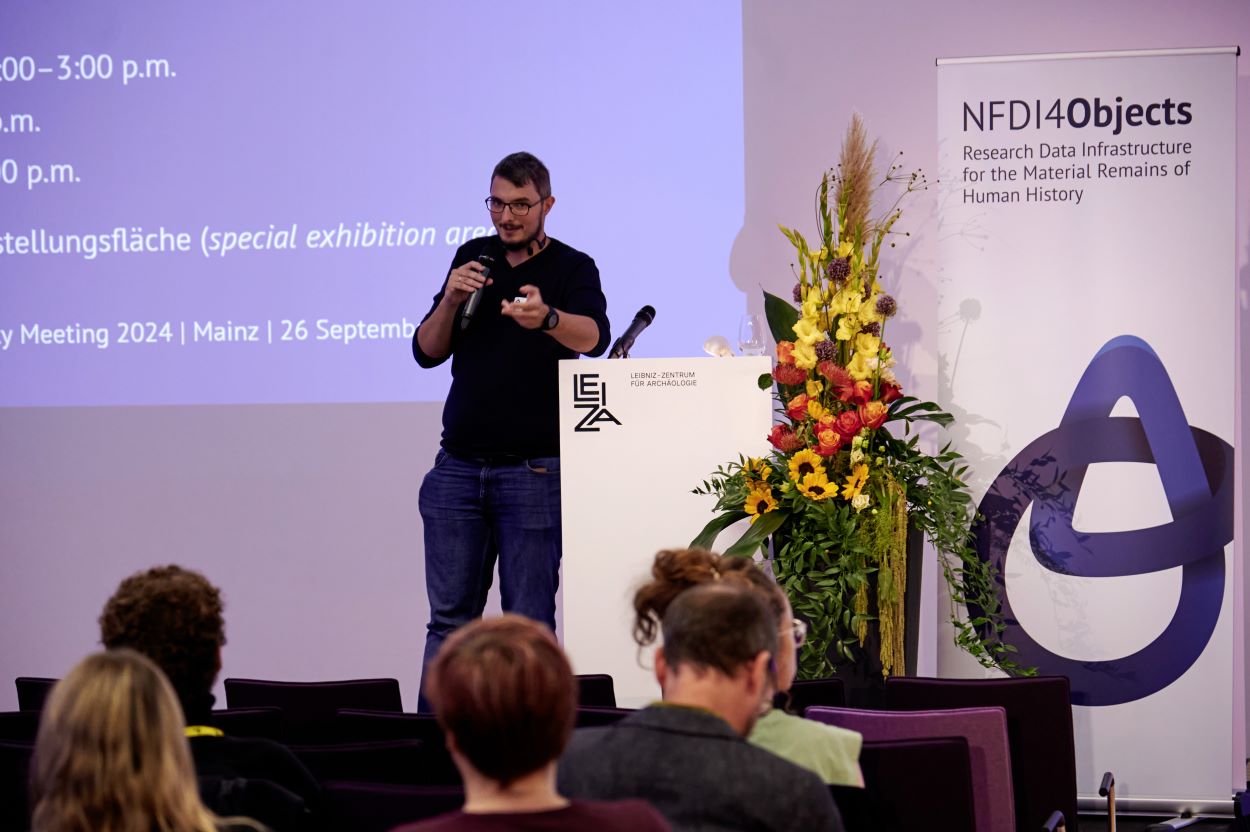
Fabian Fricke moderated the Ignite Talks. © LEIZA / Sabine Steidl
Talk 1
Teaching research data management in university teaching: a challenge
Mind the Gap! ‘Research data management: you can hardly get young students excited about it - can you?’ asked Jonathan Schmidt (Goethe University Frankfurt). With 5 or 6 slides, he demonstrated the prevailing discrepancy between supply and demand for research data management in the archaeology degree programme. However, mastering research data management is a hard skill that is in demand on the labour market at the latest. ‘What structures could fill the gap?’ he asks the audience.
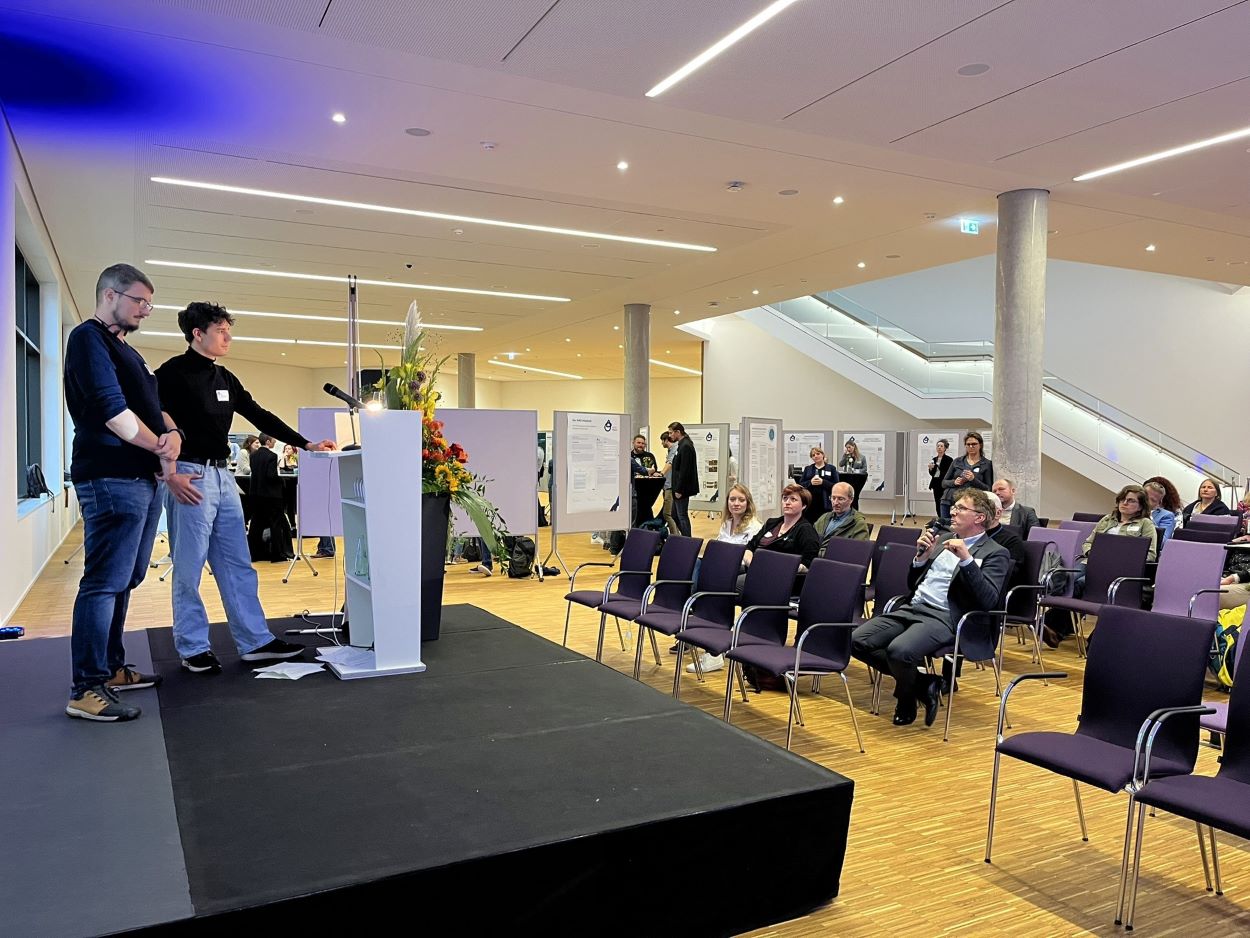
Jonathan Schmidt during the panel discussion after his Ignite Talk. © Tamina Grasme
Junior Professor Dr Dr Elisa Roßberger (Institute of Near Eastern Archaeology at the FU Berlin) responds immediately. She already offers research data collection and management as an integral part of her teaching in the BA Ancient Studies programme, which comprises a total of five archaeological subjects.
Prof. Dr Günther Görz (Faculty of Engineering, Department of Computer Science, Digital Humanities working group at FAU Erlangen) emphasises that DFG-funded projects in which research data management is mandatory promote the migration of RDM into scientific practice.
Talk 2
Hellenistic horror story? Time series analysis of ancient literature
Language model evaluation for dramatic text success: ‘If tragedies are quantified sad, does the success of (classical) texts become predictable?’ asks Lasse Mempel-Länger (Research Associate at LEIZA, NFDI4Objects Task Area 4: Protecting).
His slides show how he captured classical tragedies in Large Language Models (LLM), which represent the course of emotions in ancient works as time series. Individual sections of historical works could thus be checked to see whether they follow the ideal-typical course of tragedies with a peripeteia, the sudden dramatic turn into misfortune.
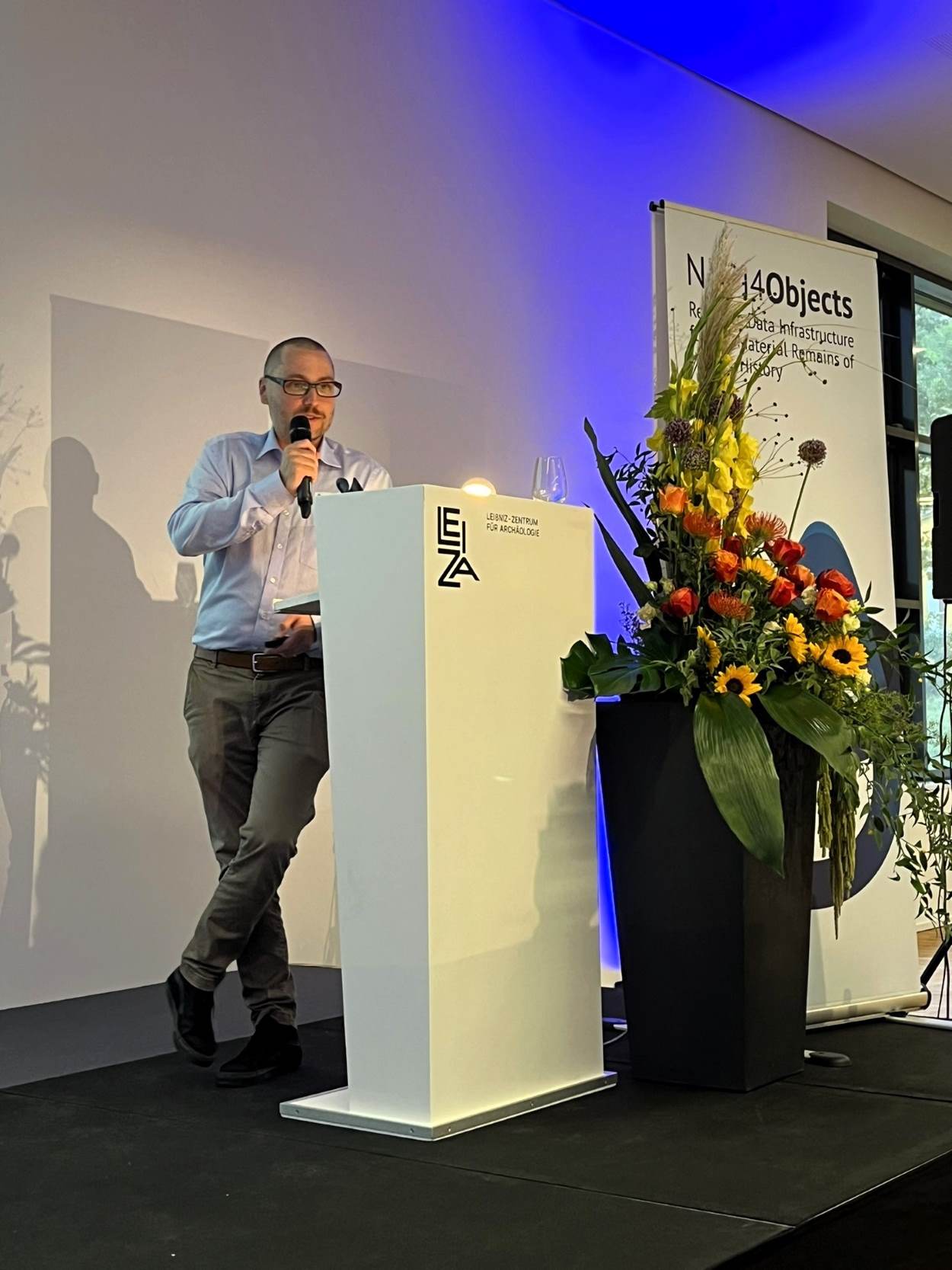
Ignite Talker Lasse Mempel-Länger on stage. © Tamina Grasme
Lukas Weimer (Base4NFDI and Text+ coordinator) enquires about the terms used for emotions and proposes the Ekman base model for the annotation of empirically proven emotions. Joy, anger, disgust, fear, contempt, sadness and surprise can thus be decoded worldwide, regardless of culture.
Romy Köhler (PhD student at the Rheinische Friedrich-Wilhelms-Universität) asks how the elaborate use of LLM is justified in his work compared to classic text analysis methods.
Lasse Mempel-Länger gives the answer himself: In order for LLM to successfully produce texts, the first step requires a language model evaluation.
Talk 3
Livin’ La Vida Localisation of old finds
No isolated solutions: Site identification in former political entities and their approximate geographical localisation is a challenge! ‘Which software can offer solutions for the NFDI?’ asks Sophie C. Schmidt (PhD student at the Institute of Prehistoric Archaeology at the FU Berlin).
Her slides show extensive research into the approximate location of the Niederguhren archaeological site, a former German district town, based on literature, Polish ministerial documents from the post-war period, the historical gazetteer https://gov.genealogy.net/ and historical ordnance survey maps. Approximate in this case means a limitation in relation to the neighbouring village and river valley. As the site is also to be published as an LOD, the uncertainty must be modelled.
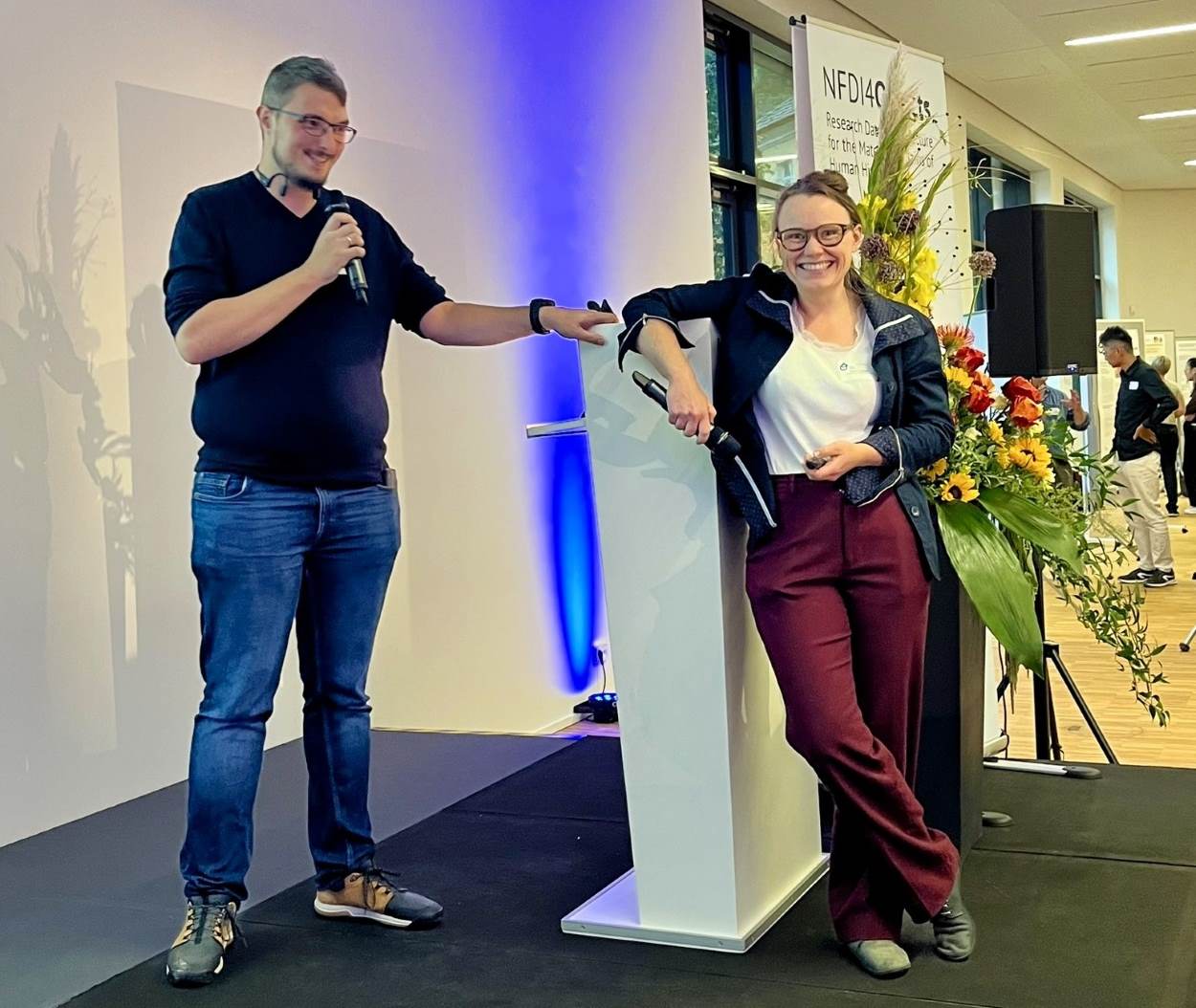
Ignite talker Sophie C. Schmidt (right) next to presenter Fabian Fricke (left) on stage. © Tamina Grasme
Sophie refers to approaches of the Research Squirrel Engineers Network with the Fuzzy Spatial Locations Ontology, which focus on presenting the source of the geoinformation, the method of coordinate creation and an assessment of the inaccuracy.
Florian Thiery (Research Software Engineer in NFDI4Objects, Task Area 2: Collecting) emphasises that mapping to CIDOC CRM is the right thing to do in order to be able to transfer the data to the NFDI4Objects knowledge graphs. He invites everyone to participate in the Temporary Working Group ‘Fuzzyness & wobbliness as RDF’ within the Community Cluster Semantic Modelling & Linked Open Data.
Talk 4
NFDI(4Objects) without Base4NFDI – a horror story
‘How can Base4NFDI and its basic services contribute to FAIR and sustainable research data management in the archaeological sciences,’ ask Franziska Fritzsche, Jana Tatscheck and Lukas Weimer (BASE4NDFI).
The talk identifies 4 problem areas:
The heterogeneity of data formats, the lack of standards for data preparation and storage, and the long-term availability and re-usability of data.
Design access! Researchers have to log in to numerous tools with different access data. Useful software is often difficult to access, proprietary or expensive. Database queries are complicated by non-standardised metadata.
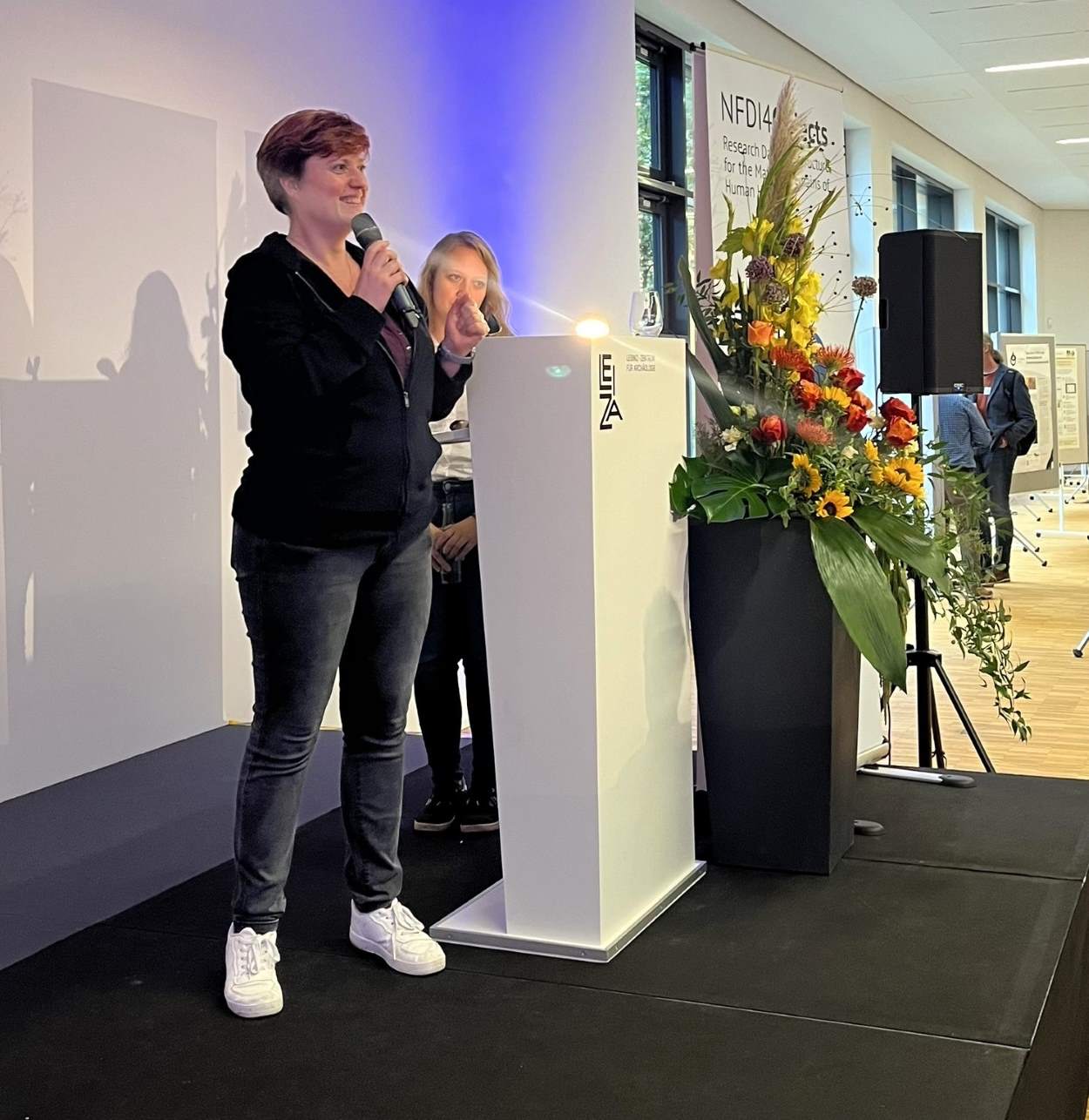
Franziska Fritzsche during her Ignite Talks for BASE4NFDI. © Tamina Grasme
In modern archaeological research, techniques such as photogrammetry are being used more and more frequently. However, not all institutes have the necessary resources to create 3D models; using a private computer is often too time-consuming.
In the area of research funding, sponsors are increasingly demanding the creation of data management plans. However, these are often only created retrospectively or superficially, meaning that valuable research data cannot be optimally processed and utilised.
To prevent this vicious circle from closing, Base4NFDI supports archaeologists in the efficient collection, storage, management and publication of FAIR research data by providing standardised tools and services.
As a joint initiative of all NFDI consortia, the aim is to establish technical and organisational solutions as basic services within the NFDI that create added value for the consortia and their users, bundle existing services, are potentially useful for all NFDI consortia and are aimed at sustainability.
Talk 5
The FAIRytale of Open Data* - FAIRlyn’s path through FAIRyland
Dreaming and acting together: ‘Is FAIR Linked Open Data just a fairy tale - a FAIRyale of Open Data,’ asks Florian Thiery (Research Software Engineer in NFDI4Objects, Task Area 2: Collecting).
His slides are an impressively animated fairy-tale book. FAIRlyn leads us into an utopian FAIRyland of freely available dragons, which are identified by Uniform Resource Identifier (URI) and can be accessed directly via HTTP and also refer to other dragons via URI. The semantics and linking of the coded kite points can be read and processed by machines using technologies such as the Resource Description Framework (RDF) and standards based on it such as the Web Ontology Language (OWL) and the SPARQL query language. The interlinked kites form a global network, which is also referred to as the ‘Linked [Open] Drachen Cloud’, ‘Giant Global Drachengraph’ or simply FAIRlyn’s ‘Knowledge Graph’.
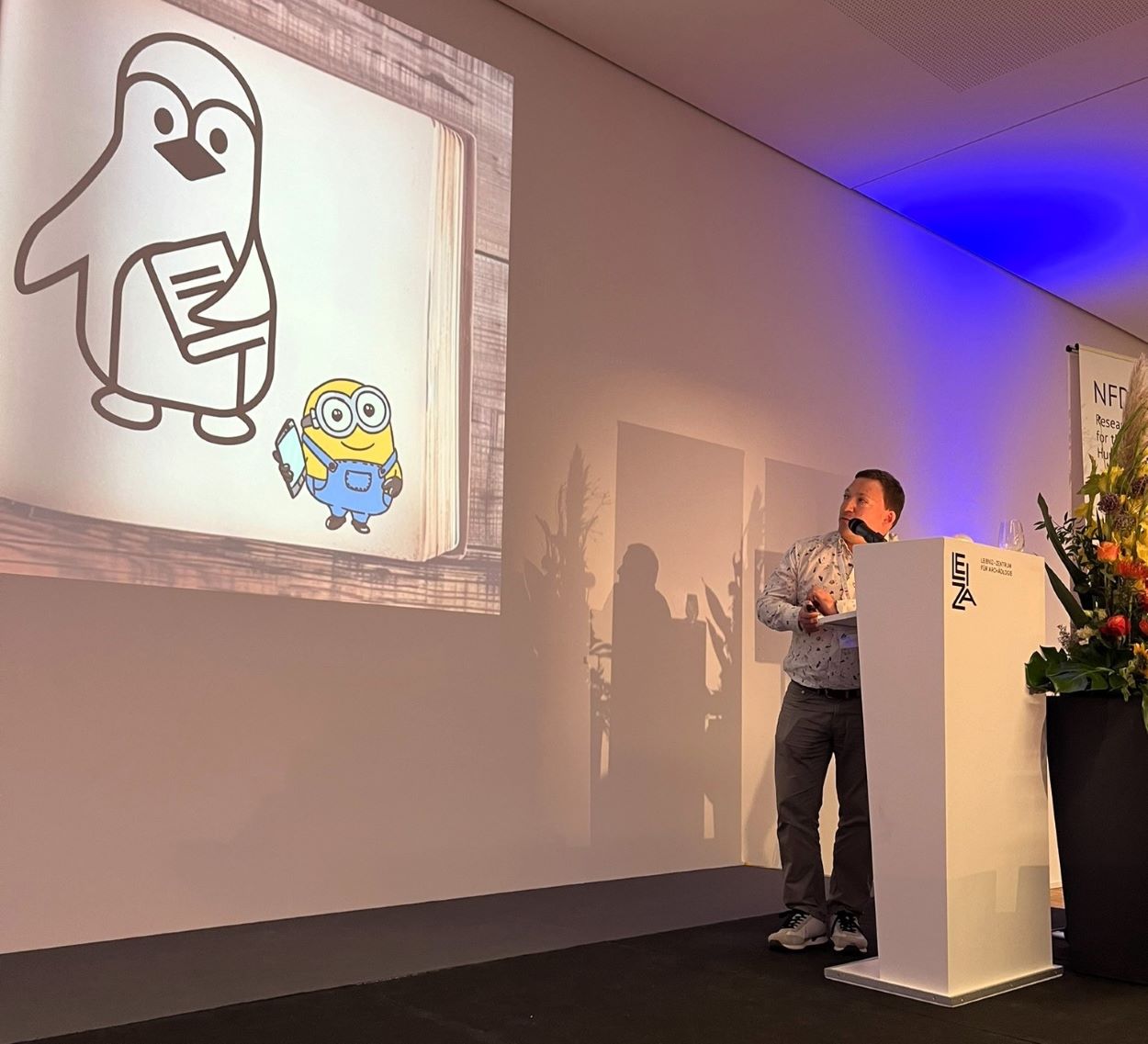
Last but not least: Florian Thierys Ignite Talk. © Tamina Grasme
Romy Köhler (PhD student at the Rheinische Friedrich-Wilhelms-Universität) asks which page of the fairy-tale book we have to turn to in order to start in the present.
FAIRlyn’s answer shows his background as an archaeoinformatician: ‘First of all, the slumbering dragons have to be freed from their caves and transformed into ’Linked [Open] Dragons!’
A great closing statement! Many thanks once again to all the speakers for these successful Ignite Talks.
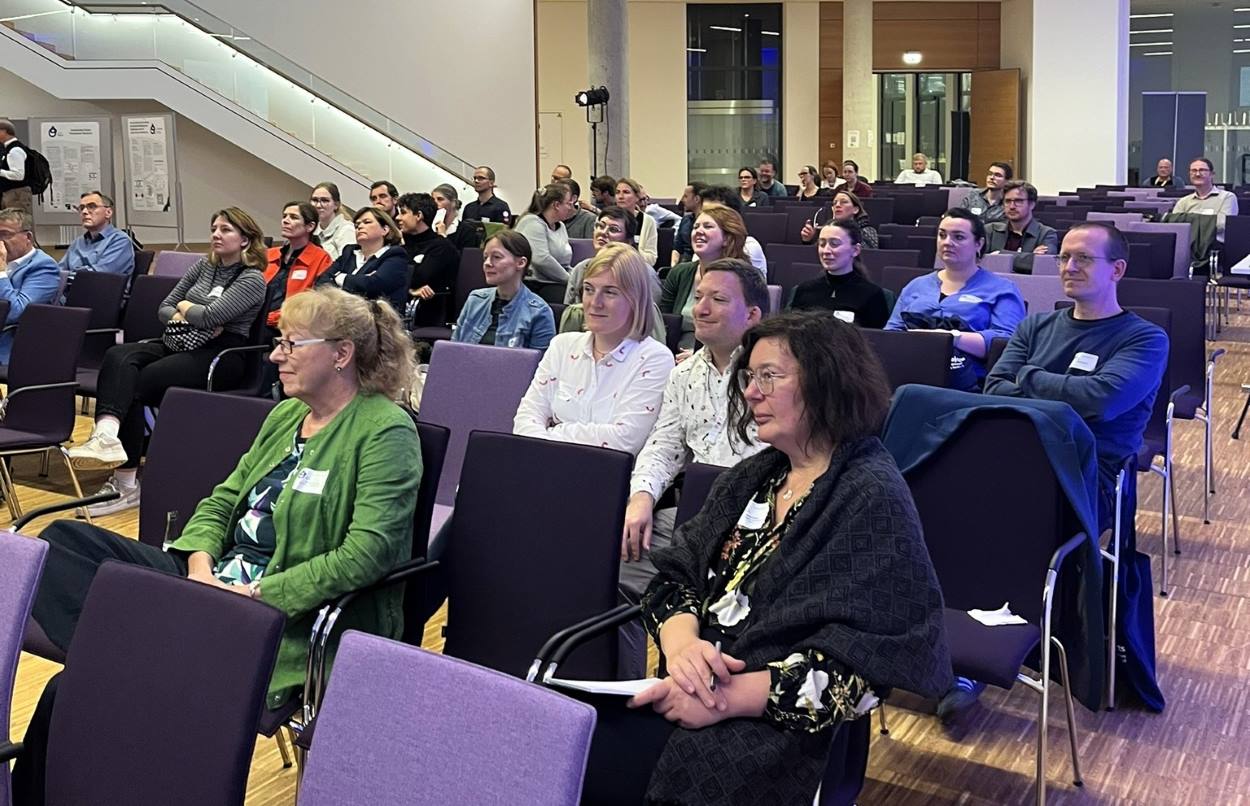
The interactive format of the Ignite Talks was particularly well received by the audience: lively discussions followed every Ignite Talk. © Tamina Grasme
Evening programme
Greeting from the Minister
The evening programme was introduced by a welcome address from the Minister for Health and Science of Rhineland-Palatinate, Clemens Hoch. The Minister emphasised the particular relevance of the National Research Data Infrastructure for Germany as a science location and, conversely, the importance of the state of Rhineland-Palatinate and the city of Mainz for the NFDI. We would like to thank the Minister for his warm words.
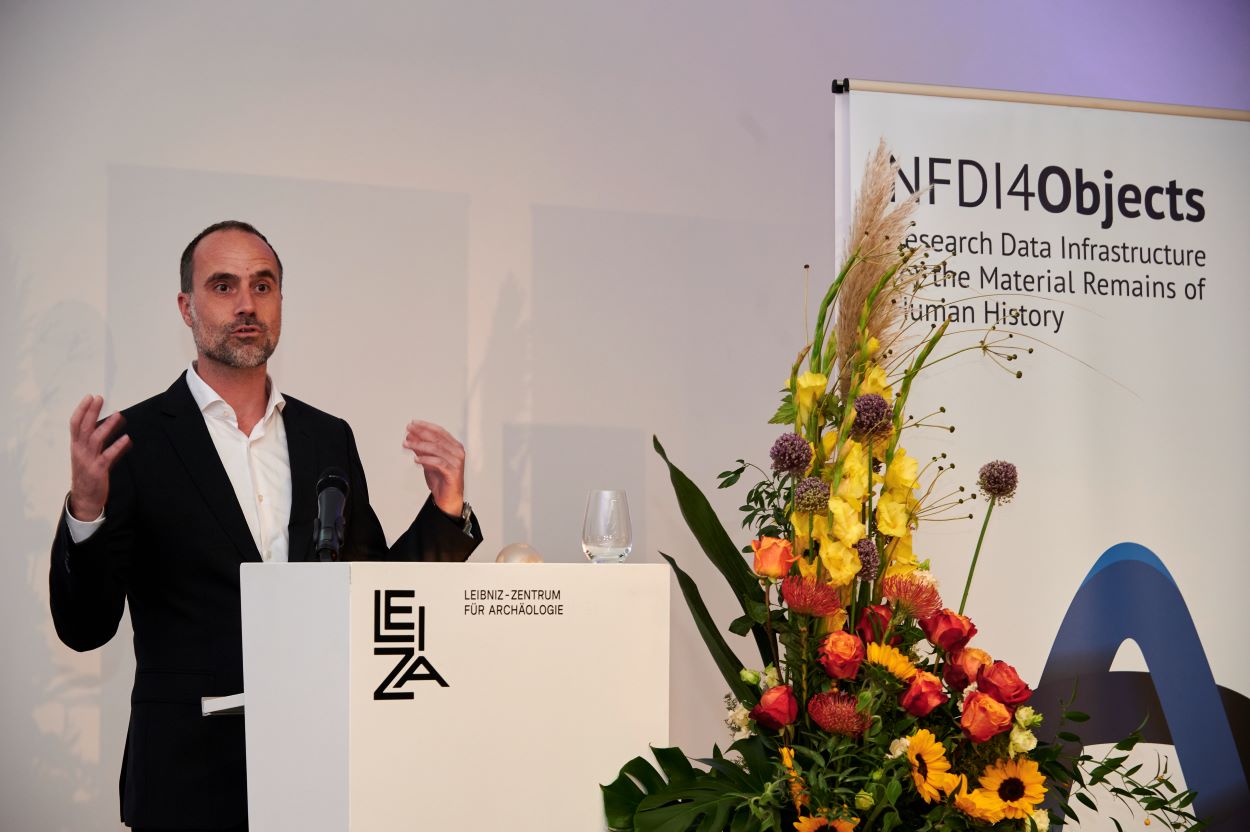
Minister Clemens Hoch introduced the evening programme. © LEIZA / Sabine Steidl
Keynote Lecture
A special highlight was the subsequent keynote lecture by Barbara Ebert, which took place on Thursday evening. The topic of the lecture was ‘Making data diversity manageable’. As co-spokesperson of the NFDI4Biodiversity consortium and managing director of the Gesellschaft für Biologische Daten e.V., she was able to share important experiences from a first round-consortium and from the development of a research data infrastructure for biodiversity data with the audience. Many thanks to Mrs Ebert for these valuable insights!
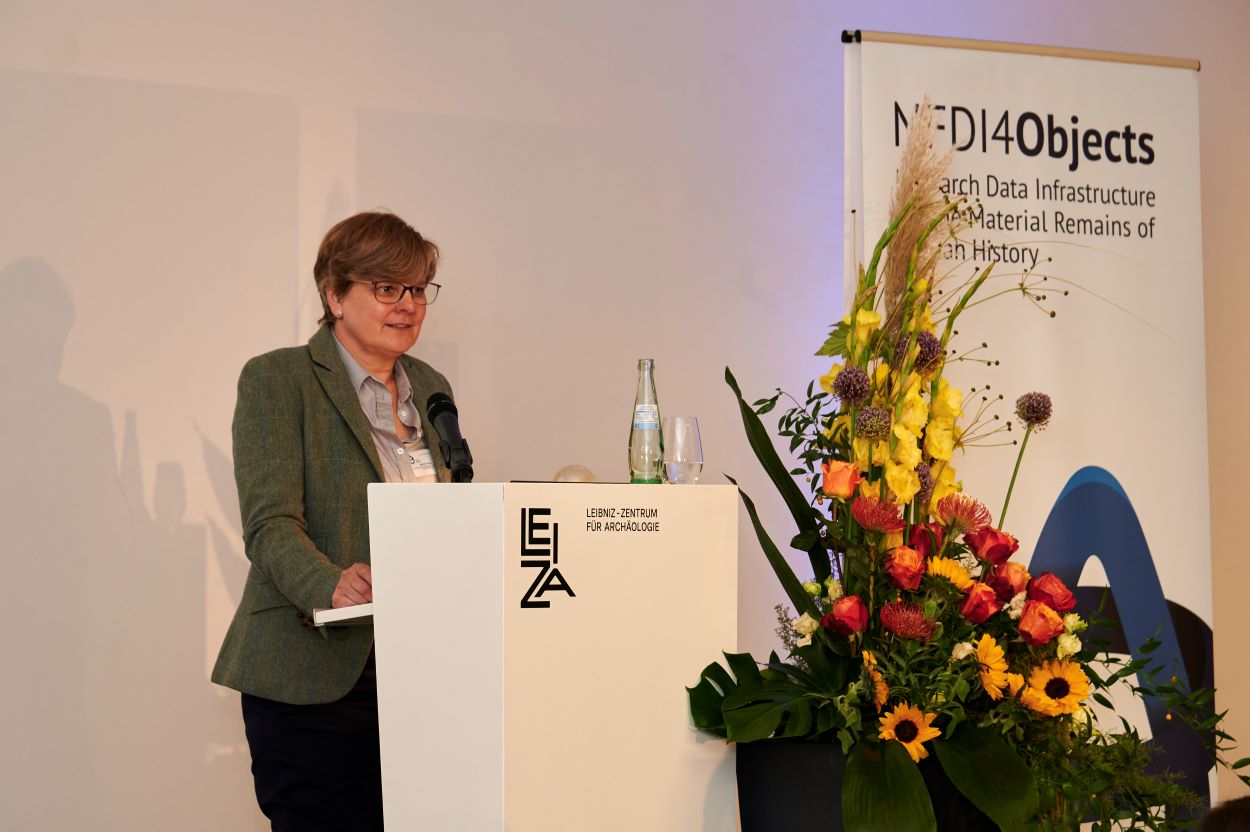
Barbara Ebert gave the Keynote Lecture. © LEIZA / Sabine Steidl
The day ended with delicious catering and music at LEIZA and offered another networking opportunity for the community.
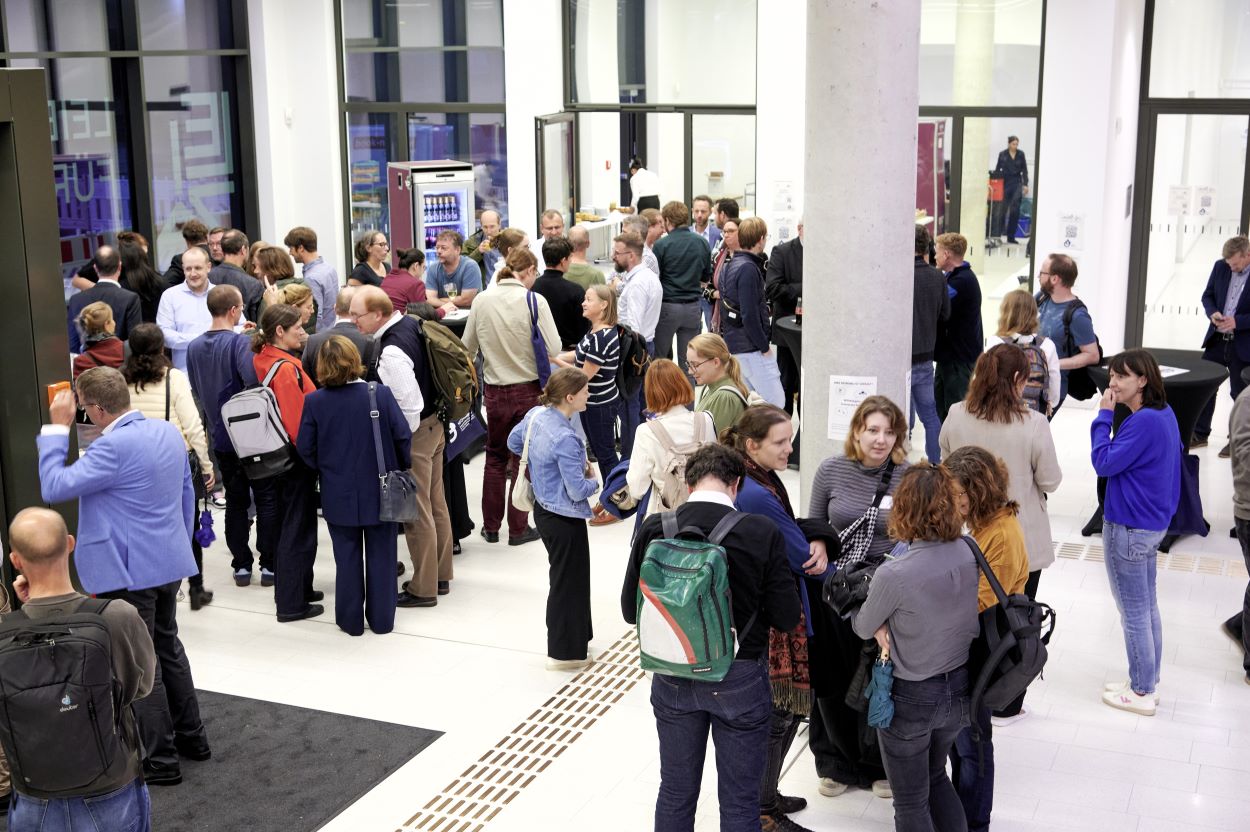
The audience enjoys food and drink in the LEIZA foyer and brings the day to a relaxed end. © LEIZA / Sabine Steidl
Day 3: Friday, 27 September
The third and final day of the conference began with the General Assembly and the meeting of the Advisory Board. This was followed by further workshops. At the same time, all interested community clusters and temporary working groups were given the opportunity to meet in person on the premises of Mainz University of Applied Sciences and to exchange and coordinate information on the work programme. The 2nd Community Meeting was concluded with short reports from the workshops and an outlook by co-spokesperson Kai-Christian Bruhn.
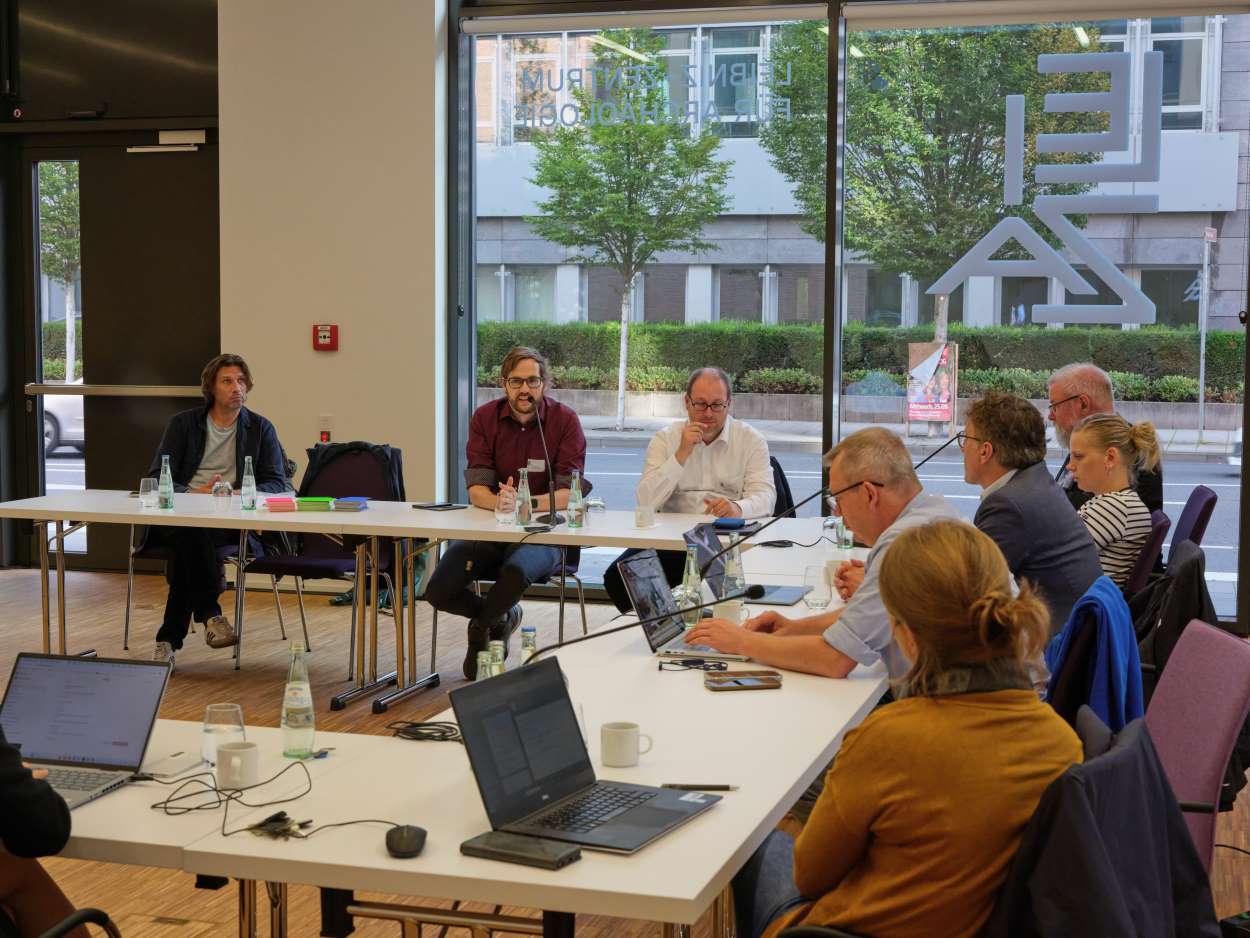
Members of the General Assembly. © LEIZA / René Müller
Workshop V
Networking with national and international initiatives & infrastructures (Christin Keller, Felix F. Schäfer)
During the workshop, networking at national and international level was discussed in depth. The focus was on specific archaeological perspectives as well as overarching initiatives such as the European Open Science Cloud (EOSC), the European Collaborative Cloud for Cultural Heritage (ECCCH) and the Social Sciences and Humanities Open Cloud (SSHOC).
The 34 participants addressed the question of which priorities should be set with regard to the development of standards and services. Approaches were discussed to promote greater harmonisation and interoperability of existing systems. At the same time, the aim was to reflect on the challenges and opportunities of recent years in order to draw practical conclusions for future developments.
The discussions made it clear that the establishment of sustainable partnerships and the promotion of an open scientific culture in particular are essential components of successful networking. Challenges such as the heterogeneity of technical infrastructures, legal framework conditions and the need for better harmonised funding models were also addressed.
The workshop provided a valuable platform for dialogue between representatives from different institutions and disciplines. Strategic measures were jointly formulated to further strengthen cooperation at national and international level and to integrate archaeological research into a broader scientific context.
Workshop VI
Harmonisation and integration of consortium services by linking decentralised systems in NFDI4Objects (Fabian Fricke, Florian Thiery, Anja Gerber)
The workshop was attended by 27 participants. It was organised by Florian Thiery, Anja Gerber and Fabian Fricke. Using the heterogeneous and multidisciplinary data from the field of archaeology, it was clearly demonstrated why standardised and structured data collection in accordance with the FAIR principles (findable, accessible, interoperable, reusable) is very important. Only in this way can data be passed on to third parties and reused by them.
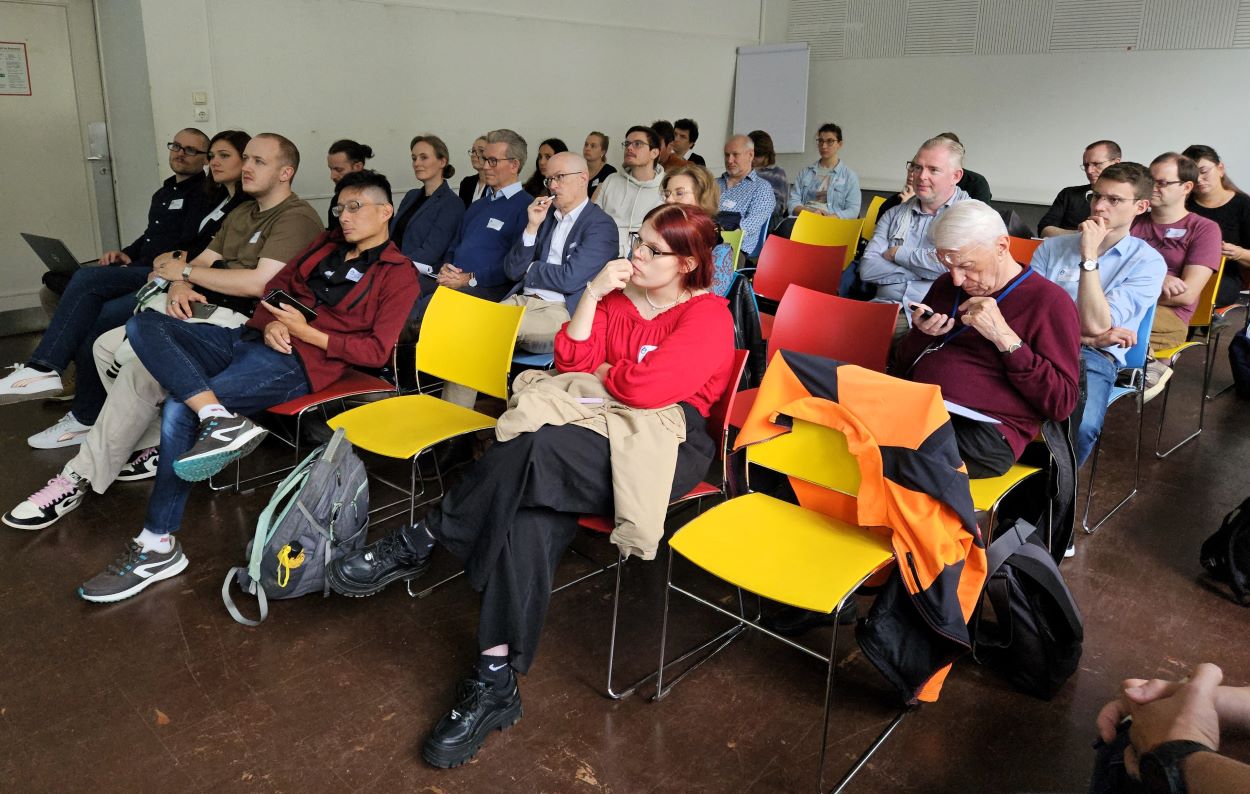
Participants of Workshop VI. © Anja Gerber
Specific case studies from work-practice, which were modelled according to the CIDOC CRM reference model and transformed from relational databases into the LIDO metadata exchange schema, clearly showed that a consensus must also be found for the use of these already established standards, as the data models were adapted to the specifics of the respective projects and were therefore also created differently. A kind of best practice must be developed for this.
In order to be able to prepare the data in the consortium for integration into the knowledge graph, the approach currently under development was presented via a N4O Minimal Metadata Set (N4O MMDS) as a ‘minimal data set’ and basis for exchange formats and the N4O Objects Ontology (N4O OO) as its semantic implementation for use in the knowledge graph.
The slides of the workshop can be found at Zenodo.
Workshop VII
Systematic RDM training programmes in NFDI4Objects (Kai-Christian Bruhn)
On Friday, 14 participants attended the workshop on the topic of qualifications and reflections on their practical implementation. The participants included students, lecturers and researchers. The discussions were lively. After a description of the existing and emerging landscape of qualification offers by institutions, regional networks and the NFDI section EduTrain as well as the data competence centres currently being set up, the open discussion focused on three topics. What is the basis for training programmes in subject areas for which no good or best practices have yet been defined? Can the development of open teaching and learning materials (OER) support the development of such community standards? How should the development and provision of practical training courses be organised?
It was concluded that best practices should also be developed in qualification programmes and that the formulation of NFDI4Objects-specific competences must form the bridge to the practical implementation of RDM in the community.
Workshop VIII
Community Engagement (Tamina Grasme)
The workshop focussed on discussing opportunities for active participation and expansion of the NFDI4Objects community. The discussion was based on the preliminary results of the community survey. Tamina Grasme, responsible for public relations and community management at NFDI4Objects, gave a brief summary of the preliminary results of the community survey and presented the consortium’s communication concept. Together with four other participants - including two students and one employee each from NFDI4Culture and Base4NFDI - the small group discussed the strengths and weaknesses of community participation in the consortium and the communication channels used.
Another focus was the topic of outreach. The expansion of the community is an important point for NFDI4Objects. Currently, it is mainly RDM professionals who are addressed by the offers made. The students in particular had the feeling that there was a lack of offers for RDM newbies. They would like to see short explanatory videos or reels on Instagram as well as workshops and further training for students on the topic of research data management - ideally integrated into the already very full framework curriculum at universities. The management will incorporate this important input into the annual planning for 2025.
Workshop IX
NFDI4Objects and specialist archaeological companies (Marco Schrickel, Doris Hartmann)
After two interesting, intensive and informative days, a small group of 15 people gathered in the large conference hall for the final workshop ‘NFDI4Objects and specialist archaeological companies: Where do we stand? Where do we want to go?’. In addition to participants from the private sector, representatives from various state offices for the preservation of historical monuments and a number of people associated with NFDI4Objects were also present.
In his introduction, Marco Schrickel showed in which federal states private excavation companies are active in archaeological surveys on behalf of public institutions. He also outlined the current status of the handling of the collected research data in relation to the goals set by NFDI4Objects for the FAIRification of the data.
The problematic variance in the guidelines for excavation documentation which was already mentioned by Marco Schrickel, which is due on the one hand to the federal system and thus the cultural sovereignty of the individual federal states and on the other hand to historical developments, was confirmed by the representatives of the specialist archaeological companies present. This fact is seen as a hindrance, particularly with regard to the comparability of excavations and excavation results or the reusability of the data generated, both for the excavation companies themselves and for scientific processing. Accordingly, the participants quickly agreed that it would be necessary to achieve a minimal, transnational standardisation of excavation documentation.
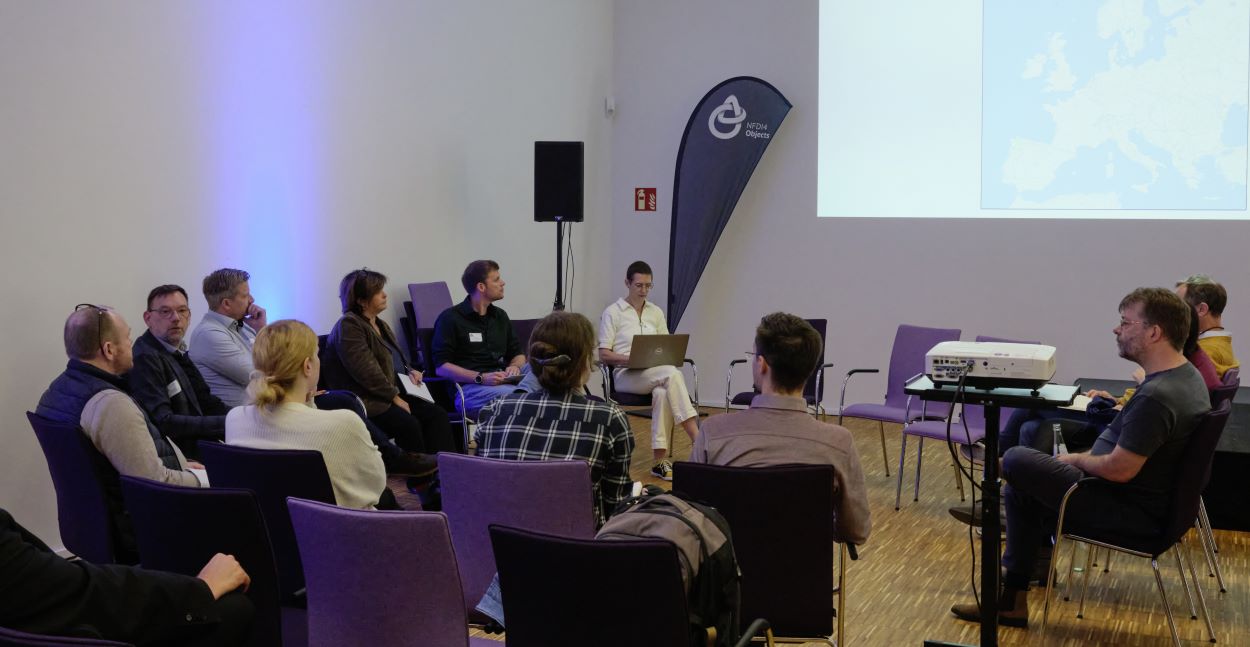
Many representatives from private-sector archaeology and the state heritage offices took part in the workshop. © LEIZA / René Müller
In the course of the further animated exchange, it was determined that NFDI4Objects can and should provide a framework in which, among other things, recommendations on minimum requirements for the written documentation of excavations and recorded metadata in the field of georeferencing and photography can be developed. The possibility of linking different actors within NFDI4Objects would make it possible to develop best practices and good standards, which in turn would lead to a sensitisation for standardisation on all sides through their exemplary effect. Another aspect that could be taken up by NFDI4Objects would be training programmes for those working in the private sector in order to qualify them in the area of FAIR data verification.
In conclusion, those present agreed that further dialogue on the points raised was necessary. However, it was not yet possible to decide on a final format for the participation of specialised companies and state monument authorities during the workshop. Further discussions will have to take place after the community meeting in order to be able to integrate the requirements into the development of NFDI4Objects in a meaningful way.
Outlook
The impulses from the community meeting will be incorporated into the future work of NFDI4Objects. The insights gained will be integrated into the strategic planning and further development of the services. In addition, the visibility of the consortium in the scientific community and the wider public was further strengthened.
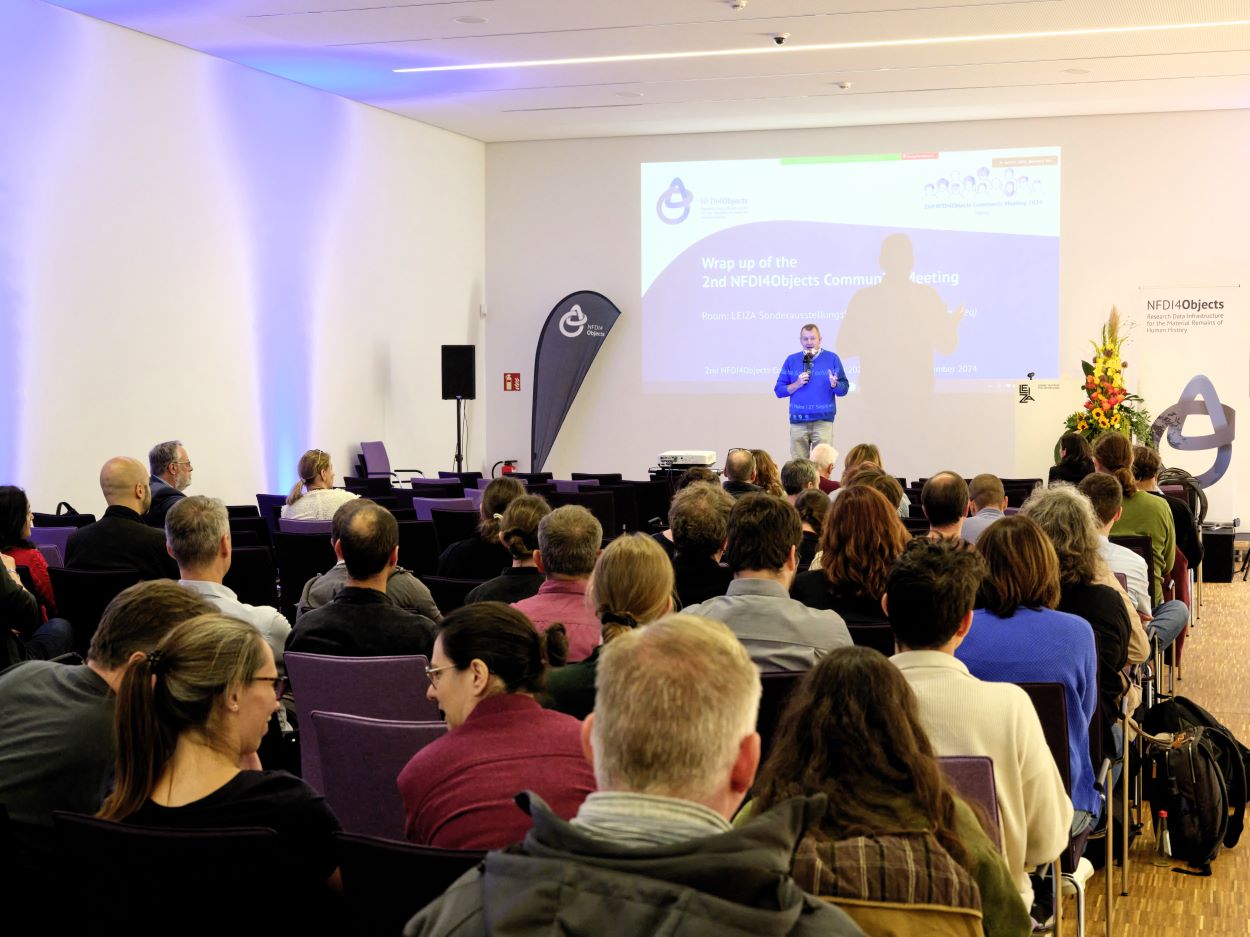
The wrap-up was moderated by Kai-Christian Bruhn. © LEIZA / René Müller
Acknowledgements
We would like to thank the hosts, the Leibniz Centre for Archaeology and Mainz University of Applied Sciences, as well as all contributors and participants who contributed to the success of the Community Meeting.
Programme
Once again this year there will be a packed programme. In inspiring talks and workshops, you will learn more about the work of our consortium, while our poster session and Ignite Talks offer space for your research and stories about research data management. In particular, we want to give students, doctoral candidates and postdocs a space to present their own work and network with other researchers. Finally, in 2024 there will again be plenty of opportunities to socialise with snacks and drinks with others from our community.
Kick-off programme
Wednesday, 25.09.2024
| Time | |
|---|---|
| 13:00 - 17:00 | Registration at the conference office (HS Mainz und LEIZA) |
| 14:00 – 17:00 | Workshop I: FDM-training for students and doctoral candidates, Chair: Kai-Christian Bruhn |
| 14:00 - 17:00 | Workshop II: From the real object to the data record - indexing archaeological objects for permanent recording in database systems, Chairs: Frank Dührkohp, Peter Baumeister |
| 14:00 – 17:00 | Workshop III: Linked Open Data using the example of RDF data, Wikidata and Wikibase, Chairs: Florian Thiery, Karsten Tolle, Tobias Arera-Rütenik |
| 14:00 – 17:00 | Workshop IV: Data Café – Perspectives on data qualification, Chairs: Bernhard Weisser, Dirk Wintergrün, Benjamin Höke |
| 16:00 - 17:00 | Meeting Steering Committee and Advisory Board |
| 17:30 – 19:00 | Icebreaker |
Main programme, Day 1 Thursday, 26.09.2024
| Time | |
|---|---|
| 08:00 – 18:00 | Registration at the conference office (LEIZA) |
| 09:00 – 09:15 | Greeting: Alexandra Busch, Words of welcome: Susanne Weissman |
| 09:15 – 09:45 | What happened so far: NFDI4Objects 2023/2024 Philipp von Rummel |
| 09:45 – 11:00 | NFDI4Objects RDM services along the Object Biography TA1, TA2 & TA3 (virtual participation possible) |
| 11:00 – 11:30 | Coffee break |
| 11:30 – 12:45 | NFDI4Objects RDM services along the Object Biography TA4, TA5 & TA6 (virtual participation possible) |
| 13:00 – 14:00 | Lunch break |
| 14:00 – 18:15 | Marketplace: Time for coffee and dialogue Poster Session (Open Call) Ignite Talks: Persönliche Daten-(Horror)Geschichten zum Schmunzeln (Open Call) Sneak Peek: NFDI4Objects Dataship |
| 18:15 – 20:00 | Greeting: Clemens Hoch (Minister für Wissenschaft und Gesundheit des Landes Rheinland-Pfalz), Keynote Lecture: Barbara Ebert (Gesellschaft für Biologische Daten e.V., GFBio) |
| 20:00 – 23:00 | Reception & Get Together. |
Main programme, Day 2 Friday, 27.09.2024
| Time | |
|---|---|
| 08:30 – 10:30 | General Assembly |
| 09:00 – 11:00 | Hands-on: NFDI4Objects Tools & Services |
| 10:30 – 11:00 | Coffee Break |
| 11:00 – 13:00 | Open Forum: Meeting of the NFDI4Objects Community Cluster and Temporary Working Groups |
| 11:00 – 13:00 | Workshop V: Networking with national and international initiatives & infrastructures, Chair: Chris Keller, Felix F. Schäfer |
| 11:00 – 13:00 | Workshop VI: Harmonisation and integration of consortium services by linking decentralised systems in NFDI4Objects, Chairs: Fabian Fricke, Florian Thiery, Anja Gerber |
| 11:00 – 13:00 | Workshop VII: Systematic RDM training programmes in NFDI4Objects, Chairs: Kai-Christian Bruhn |
| 11:00 – 13:00 | Workshop VIII: Community Engagement, Chair: Tamina Grasme |
| 11:00 - 13:00 | Workshop IX: NFDI4Objects and specialist archaeological companies: Where do we stand? Where do we want to go? Chairs: Marco Schrickel, Doris Hartmann |
| 13:00 – 14:00 | Reports from the CCs, TWGs & workshops and conclusion (virtual participation possible) |
| 14:00 | End of Conference |
The current programme including the location and room number can be found here
Please note that there may be changes to the programme at short notice. These changes will be continuously updated on our event page.
Live-Stream
Unfortunately, you cannot attend our Community Meeting in person, but would still like to follow the presentations on Thursday about NFDI4Objects and our services?
Then switch on our livestream! Our main programme on Thursday, 26 September 2024, will be broadcast live via Zoom. The Zoom room is open, no registration is necessary.
Thursday, 26.09.2024
Main programme, 8:30 am - 1:30 pm
- Welcome, annual review of NFDI4Objects, presentations from the task areas
-
Room: https://rgzm-de.zoom.us/j/83116804906?pwd=VEsS9ggaXBXAeapSiMeqo8oIWiG6Ga.1
- Meeting ID: 831 1680 4906
- Identification code: 568101
Main programme, 17:30 - 20:00
- Greeting by the Minister, Keynote Lecture
-
Room: https://rgzm-de.zoom.us/j/88215344918?pwd=vbHAP1i8F0pbjFrxxCo9PbJm2ZRIFg.1
- Meeting ID: 882 1534 4918
- Identification code: 894946
Hybrid Meeting of the Life Sciences Community Cluster, from 15:00
Friday, 27.09.2024
Main programme, 13:00 - 14:00
- Wrap-up of the 2nd Community Meeting
-
Room: https://rgzm-de.zoom.us/j/85815784050?pwd=26TFO4JaN2yhi3RKukhQXmrx0mRzbD.1
- Meeting ID: 858 1578 4050
- Identification code: 592975
Registration
We do not charge a participation fee for our Community Meeting. However, registration for the conference and workshops is required. The registration deadline for the Community Meeting ended on 13.09.2024.
Unfortunately, registration is no longer possible.
How to find us
Here you can find out how to get to our conference locations (LEIZA and Mainz University of Applied Sciences) for the 2nd NFDI4Objects Community Meeting in Mainz.
LEIBNIZ-ZENTRUM FÜR ARCHÄOLOGIE (LEIZA)
Adress
Leibniz-Zentrum für Archäologie Ludwig-Lindenschmit-Forum 1 55116 Mainz
Directions
By public transport
- Stop Mainz, Römisches Theater, on foot to LEIZA ca. 200 meters
- Stop Mainz, Stadtpark, on foot to LEIZA ca. 50 meters
Accessibility: The Römisches Theater S-Bahn station has a lift.
By car
- We would ask you to use public transport if possible. If there are special reasons for travelling by car, please follow the directions below: Ludwig-Lindenschmit-Forum 1, 55116 Mainz (alternatively: Neutorstr. 2)
- Coming from the A 60 motorway, take the Mainz city centre exit. Follow Wormser Straße and turn left at the railway bridge into Rheinstraße. Then turn left into Holzhofstr. and at the 1st traffic lights turn left into Neutorstr.
- Coming from the A 671 motorway, take the Mainz-Kastel exit. Follow the main road in the direction of Mainz, then cross the Rhine bridge and then get into the left-hand lane and turn left into Rheinstr. Follow Rheinstr. until the junction with Holzhofstr. Turn right into Holzhofstr. and then left into Neutorstr.
You can park here
There are several multi-storey car parks in the vicinity of the Leibniz Centre for Archaeology where cars can be parked for a fee.
- Cinestar multi-storey car park, Neutorstr. 2a, 55116 Mainz
- CONTIPARK underground car park Malakoff Passage, Dagobertstraße, 55116 Mainz
- Römisches Theater multi-storey car park, Holzhofstraße 7, 55116 Mainz
Accessibility: All three car parks have a lift.
Campus HOCHSCHULE MAINZ
Adress
Hochschule Mainz – University of Applied Sciences Lucy-Hillebrand-Str. 2 55128 Mainz
Directions
By public transport
- Tram line 51 in the direction of Lerchenberg or Finthen, stops ‘Jakob-Heinz-Straße/Arena’ and ‘Hochschule Mainz’
- Tram line 53 in the direction of Lerchenberg or Hechtsheim, stops ‘Jakob-Heinz-Straße/Arena’ and ‘Hochschule Mainz’
- Tram line 59 in the direction of ‘Hochschule Mainz’, stops ‘Jakob-Heinz-Straße/Arena’ and ‘Hochschule Mainz’
- Bus route 9 in the direction of ‘Jakob-Heinz-Straße/Arena’, bus stops ‘Hochschule Mainz/Campusbrücke’ and ‘Jakob-Heinz-Straße/Arena’
- Bus route 650 in the direction of ‘Sprendlingen’, bus stop ‘Hochschule Mainz/Campusbrücke’
- You can find the timetable for line 650 on the RNN (Rhein-Nahe Nahverkehrsverbund) website.
- Bus route 75 (Mainz main station > Mainz University of Applied Sciences > Essenheim > Elsheim > Schwabenheim > Ingelheim and vice versa), bus stop ‘Hochschule Mainz/Campusbrücke’
- You can also reach the university on the following bus route, which does not pass Mainz main station:
- Bus route 74 (Mombacher Kreisel > Gonsenheim/Elbestraße > Hochschule Mainz > Hechtsheim/Mühldreieck and vice versa), bus stop ‘Hochschule Mainz/Campusbrücke’
All bus routes and departure times can be found on the website www.mainzer-mobilitaet.de.
By car
- We would ask you to use public transport if possible. If there are special reasons for travelling by car, please follow the directions below: Lucy-Hillebrand-Str. 2, 55128 Mainz
- Coming from the A60 motorway, take the exit MZ-Finthen / Innenstadt. Follow Saarstraße and turn right after the Mainz Kisselberg stop (crossing the tram tracks). Turn left at the traffic lights onto Koblenzer Straße. At the next set of traffic lights, turn right onto the campus of Mainz University of Applied Sciences. You have reached your destination.
You can park here
- The Mainz University of Applied Sciences campus has an open, free car park (see directions above).
Accessibility: The car park at Mainz University of Applied Sciences is not completely barrier-free as it does not have a lift. Persons with disabilities should therefore park on the ground-level car park deck.
LUX - PAVILION OF THE UNIVERSITY OF APPLIED SCIENCES MAINZ
Adress
LUX – Pavillon der Hochschule Mainz Ludwigsstraße 2 55116 Mainz
Directions
By public transport
The following bus and tram lines will take you from the main railway station to the ‘Schillerplatz’ stop at the LUX - Pavillon site of Mainz University of Applied Sciences:
- Tram line 50 in the direction of Mainz Bürgerhaus, stop ‘Schillerplatz’
- Tram line 52 in the direction of Mainz-Hechtsheim Am Schinnergraben, stop ‘Schillerplatz’
- Tram line 53 in the direction of Mainz Bürgerhaus, ‘Schillerplatz’ stop
- Bus route 57 in the direction of Wiesbaden-Mainz-Kastel Krautgärten, ‘Schillerplatz’ stop
- Bus route 61 in the direction of Mainz Riedweg, bus stop ‘Schillerplatz’
- Bus route 62 in the direction of Mainz Wildpark, bus stop ‘Schillerplatz’
All bus routes and departure times can be found on the website www.mainzer-mobilitaet.de.
By car
- We would ask you to use public transport if possible. If there are special reasons for travelling by car, please follow the directions below: Schillerstraße, 55116 Mainz.
- The Schillerplatz multi-storey car park is located directly on Schillerplatz, where cars can be parked for a fee. The LUX is a two-minute walk from the multi-storey car park.
Accessibility: The Schillerplatz multi-storey car park has a lift. The LUX is not completely barrier-free!
HOCHSCHULE MAINZ – LOCATION HOLZSTRAßE
Adress
Hochschule Mainz Holzstraße 36 55116 Mainz
Directions
By public transport
The following bus lines will take you from the main railway station to the bus stop ‘Holzturm/Malakoff-Passage’ at the Holzstraße location:
- Bus route 60: From Hauptbahnhof West and Hauptbahnhof via Schillerplatz and Höfchen in the direction of Ginsheim
- Bus route 61: From the main railway station via Schillerplatz and Höfchen in the direction of Mainz-Laubenheim
- Bus route 63: From Hauptbahnhof West and Hauptbahnhof via Schillerplatz and Höfchen in the direction of Weisenau
- The ‘Mainz Römisches Theater’ railway station is located near the Holzstraße site. From the ‘Römisches Theater’ station, you can reach the Holzstraße location via Dagobertstraße or Holzhofstraße, for example, which you follow to Rheinstraße. At Rheinstraße, turn left and follow the road to the corner of Rheinstraße and Holzstraße.
All bus routes and departure times can be found on the website www.mainzer-mobilitaet.de.
By car
- We would ask you to use public transport if possible. If there are special reasons for travelling by car, please note that the Holzstraße location does not provide any parking facilities.
You can park here
There are several multi-storey car parks in the vicinity of the Holzstraße location where cars can be parked for a fee:
- Rheingoldhalle multi-storey car park, Rheinstraße 66, 55116 Mainz
- Römisches Theater multi-storey car park, Holzhofstraße 7, 55116 Mainz (directly at LEIZA)
- Cinestar multi-storey car park, Neutorstr. 2a, 55116 Mainz (directly at LEIZA)
Accessibility: All three car parks have a lift.
WEDNESDAY: YOUR WAY FROM THE CAMPUS OF THE UNIVERSITY OF APPLIED SCIENCES MAINZ TO LUX
By public transport
The following bus and tram lines will take you from the campus of Mainz University of Applied Sciences (stop ‘Bretzenheim - Hochschule Mainz’) to the stop ‘Schillerplatz’ at the LUX - Pavillon site of Mainz University of Applied Sciences:
- Tram line 53 in the direction of Mainz-Hechtsheim Bürgerhaus, stop ‘Schillerplatz’
- Tram line 51 in the direction of Mainz-Finthen Poststraße to Mainz Hbf West / Taubertsbergbad; from there take bus line 60 in the direction of Ginsheim-Gustavsburg-Ginsheim Neckarstraße, bus stop ‘Schillerplatz’
Accessibility: Not all trams operating from Mainz University of Applied Sciences are barrier-free. Persons with disabilities should therefore allow sufficient time for travelling between the campus and LUX.
Reimbursement of travelling expenses
Do you have limited financial resources as a student, doctoral candidate or early career researcher, but would still like to attend our Community Meeting from 25 to 27 September in Mainz? We can support you: Under certain conditions, you can apply for reimbursement of your travel expenses.
You can download the application form as a PDF here:
The following conditions must be met in order to receive reimbursement of travel expenses:
- You are enrolled at a German college/university for a Bachelor’s, Master’s or doctoral programme (students, doctoral candidates)
- or: You completed your doctorate less than three years ago and are working in a temporary post-doc position (early career researcher)
- You complete the application for reimbursement of travel expenses in full and send it to us by the deadline of 18 October 2024
In addition, at least one of the following three requirements for reimbursement of travel expenses must be met:
- You attend one of our workshops at the Community Meeting (e.g. FDM training for students and doctoral candidates)
- or: You submit an abstract for an Ignite Talk and present during our Marketplace
- or: You write a report on the Community Meeting that can be used for our public relations work (social media, newsletter, website).
We look forward to your participation and contributions! If you have any questions, please contact our helpdesk by e-mail (n4o-helpdesk@dainst.de). Thank you very much.